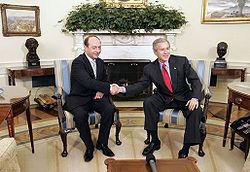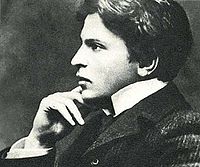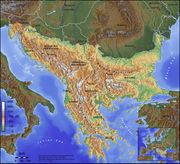Romania
|
|||||||||||||||||||||||||||||||||||||||||||||||||||||||||||||||||||||||||||||||||||||||||||||||||||||||||||||||||||||||||||||||||||||||||||
Romania (pronounced /roʊˈmeɪniə/ (![]() listen) roe-MAY-nee-ə; dated: Rumania; Romanian: România [romɨˈni.a] (
listen) roe-MAY-nee-ə; dated: Rumania; Romanian: România [romɨˈni.a] (![]() listen)) is a country located at the crossroads of Central and Southeastern Europe, north of the Balkan Peninsula, on the Lower Danube, within and outside the Carpathian arch, bordering on the Black Sea.[3] Almost all of the Danube Delta is located within its territory. Romania shares a border with Hungary and Serbia to the west, Ukraine and the Republic of Moldova to the northeast, and Bulgaria to the south.
listen)) is a country located at the crossroads of Central and Southeastern Europe, north of the Balkan Peninsula, on the Lower Danube, within and outside the Carpathian arch, bordering on the Black Sea.[3] Almost all of the Danube Delta is located within its territory. Romania shares a border with Hungary and Serbia to the west, Ukraine and the Republic of Moldova to the northeast, and Bulgaria to the south.
Romania emerged as principalities of Moldavia and Wallachia united under prince Alexandru Ioan Cuza in 1859 and as the Kingdom of Romania under the Hohenzollern monarchy, it gained recognition of independence from the Ottoman Empire in 1878. Romanian Independence Day is May 9, 1877. In 1918, at the end of the World War I, Transylvania, Bukovina and Bessarabia united with the Kingdom of Romania. At the end of World War II, parts of its territories (roughly the present day Republic of Moldova and the southern half of Odessa oblast (today in Ukraine) were occupied by the Soviet Union and Romania became a socialist republic, member of the Warsaw Pact.
With the fall of the Iron Curtain and the 1989 Revolution, Romania started a series of political and economic reforms. After a decade of post-revolution economic problems, Romania made economic reforms such as low flat tax rates in 2005 and joined the European Union on January 1, 2007. Romania is now an upper-middle income country with high human development,[4] although within the European Union, Romania's income level remains one of the lowest.
Romania has the 9th largest territory and the 7th largest population (with 21.5 million people)[5] among the European Union member states. Its capital and largest city is Bucharest (Romanian: Bucureşti [bukuˈreʃtʲ] (![]() listen)), the 6th largest city in the EU with 1.9 million people. In 2007 the city of Sibiu was chosen as a European Capital of Culture.[6] Romania also joined NATO on March 29, 2004, and is also a member of the Latin Union, of the Francophonie, of the OSCE and of the United Nations, as well as an associate member of the CPLP. Romania is a semi-presidential unitary state.
listen)), the 6th largest city in the EU with 1.9 million people. In 2007 the city of Sibiu was chosen as a European Capital of Culture.[6] Romania also joined NATO on March 29, 2004, and is also a member of the Latin Union, of the Francophonie, of the OSCE and of the United Nations, as well as an associate member of the CPLP. Romania is a semi-presidential unitary state.
Contents |
Etymology
The name of Romania (Romanian: România) comes from Romanian: român which is a derivative of the Latin: Romanus (Roman).[7] The fact that Romanians call themselves a derivative of Romanus (Romanian: Român/Rumân) is first mentioned in the 16th century by Italian humanists travelling in Transylvania, Moldavia and Wallachia.[8][9][10][11] The oldest surviving document written in the Romanian language is a 1521 letter known as "Neacşu's Letter from Câmpulung".[12] This document is also notable for having the first occurrence of "Rumanian" in a Romanian written text, Wallachia being here named The Rumanian Land – Ţeara Rumânească (Ţeara from the Latin: Terra land).
In the following centuries, Romanian documents use interchangeably two spelling forms: român and rumân.[note 1] Socio-linguistic evolutions in the late 17th century led to a process of semantic differentiation: the form "rumân", presumably usual among lower classes, got the meaning of "bondsman", while the form român kept an ethno-linguistic meaning.[13] After the abolition of serfdom in 1746, the form "rumân" gradually disappears and the spelling definitively stabilises to the form "român", "românesc".[note 2] Tudor Vladimirescu, a revolutionary leader of the early 19th century, used "Rumânia" to refer exclusively to the principality of Wallachia, the southern part of modern Romania.[14] The name "România" as common homeland of all Romanians is documented in the early 19th century.[note 3] This name has been officially in use since December 11, 1861.[15]
English-language sources still used the terms "Rumania" or "Roumania", borrowed from the French spelling "Roumanie", as recently as World War II,[16] but since then those terms have largely been replaced with the official[17] spelling "Romania".
History
Prehistory and Antiquity
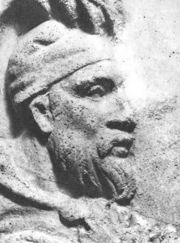
The oldest modern human remains in Europe were discovered in the "Cave With Bones" in present day Romania.[18] The remains are approximately 42,000 years old and as Europe’s oldest remains of Homo sapiens, they may represent the first such people to have entered the continent.[19] But the earliest written evidence of people living in the territory of the present-day Romania comes from Herodotus in book IV of his Histories (Herodotus) written 440 BCE, where he writes about the Getae tribes.[20]
Dacians, considered a part of these Getae, were a branch of Thracians that inhabited Dacia (corresponding to modern Romania, Moldova and northern Bulgaria). The Dacian kingdom reached its maximum expansion during King Burebista, between 82BC - 44 BC, and soon came under the scrutiny of the neighbouring Roman Empire. After the assassination of Burebista, Dacia split into 4 or 5 smaller kingdoms, the Romans conquering Moesia by 29 BC. The Dacian Wars, between 87 AD - 106 AD ended with the victory of the Romans, and the transforming of the core of the kingdom into the province of Roman Dacia.[21]
Dacia was famed for its rich ore deposits, and especially gold and silver were plentiful.[22] Rome colonized Dacia Felix with colonists from all over the empire ("ex toto orbe Romano infinitas") .[23] This brought Vulgar Latin and started a period of intense romanization, that would give birth to proto-Romanian language.[24][25] Nevertheless, the attacks on the province by the Goths and the free dacian tribes of Carpi between 240AD - 256AD, at which date "Dacia was lost", Rome withdrew its administration from Dacia around 271 AD, thus making it the first province to be abandoned.[26][27]
Several competing theories have been generated to explain the origin of modern Romanians. Linguistic and geo-historical analysis tend to indicate that Romanians have coalesced as a major ethnic group both South and North of the Danube.[28] For further discussion, see Origin of Romanians.
Middle Ages
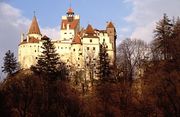
After the Roman army and administration left Dacia, the territory was held by the Goths,[29] then, in the 4th century by Huns.[30] They were followed by the Gepids,[31][32] Avars,[33] Bulgars,[31] Pechenegs,[34] and Cumans.[35] The Slavs also settled this land during this period.
In the Middle Ages, Romanians (Vlachs) lived in three principalities: Wallachia, Moldavia and Transylvania.
Since the 11th century, Transylvania had been part of the Kingdom of Hungary with a largely autonomous status.[36] In the year 1366, king Louis I Anjou of Hungary issued a law-and-order Decree of Turda[37] in part explicitly targeted against the Romanians from Transylvania (presumptuosam astuciam diversorum malefactorum, specialiter Olachorum,1 in ipsa terra nostra existencium - the evil arts of many malefactors, especially Vlachs /Romanians that live in our country; exterminandum seu delendum in ipsa terra malefactores quarumlibet nacionum, signanter Olachorum - to expel or exterminate from this country malefactors belonging to any nation, especially Vlachs/Romanians).
Through the same decree, Hungarian nobility (nobilis Hungarus) is partially redefined in terms of adherence to the Roman Catholic Church, thus excluding the Eastern Orthodox schismatic Romanians. Another consequence of the decree was socio-economic: the status of nobleman was determined not only by ownership over land and people, but (from 1366 on) by the possession of a royal donation certificate for the land owned.
The Romanian social elite, chiefly made up of aldermen (iudices or knezes), managed to procure few writs of donation; they had ruled over their villages according to the old law of the land (ius valachicum, with its feudal version, ius keneziale); their lands were, to a great extent, expropriated. Lacking a recognized title to real property, the Eastern Orthodox Romanian elite was no longer able to maintain an Estate of their own or to participate in the country's assemblies. Insofar as a Romanian elite was preserved, it adjusted to these circumstances by converting to Roman Catholicism and being absorbed into Hungarian Catholic aristocratic estate (nobilis Hungarus). Those Romanian knezes (and voivods) who did not convert and could not gain the desired privileges gradually declined into the ranks of subjects or even bondsmen.
A few years prior, Wallachian Romanians led by Basarab I defeated Charles I Anjou of Hungary at the Battle of Posada. From 1438 Transylvania was governed by the Union of Three Nations formed by the Hungarian nobility, the ethnically Hungarian Székely and Germans. In 1526 the Ottoman Empire conquered southern and central Hungary, and Transylvania became part of the Eastern Hungarian Kingdom ruled by the Habsburgs. In 1571 the Eastern Hungarian Kingdom ceased to exist, and a semi-independent Principality of Transylvania came under Ottoman suzerainty.[38] From 1661 onwards Transylvania came under the rule of the Habsburg Empire.[39]
Small Voivodeships with varying degrees of independence developed from the beginning of the 13th century, but only in the 14th century did the larger principalities of Wallachia (1310) and Moldavia (around 1352) consolidate enough to oppose the neighbouring Kingdom of Hungary, Polish kingdom, and the Ottoman Empire.[40][41] Basarab I, Mircea the Elder, Vlad III the Impaler in Wallachia, Alexander the Good, Stephen the Great in Moldavia, developed the Romanian countries, and fought to maintain independence at a crossroad of empires.
By 1541, the entire Balkan peninsula and the central part of Hungary became Ottoman provinces. In contrast, Moldavia, Wallachia and Transylvania came under Ottoman suzerainty, but conserved a great degree of internal autonomy and, until the 18th century, some external independence. During this period these countries witnessed the slow disappearance of the feudal system; the distinguishment of rulers like Vasile Lupu and Dimitrie Cantemir in Moldavia, Matei Basarab and Constantin Brâncoveanu in Wallachia, John Hunyadi (Iancu de Hunedoara) and Gabriel Bethlen in Transylvania.[42]

In 1600, the principalities of Wallachia, Moldova and Transylvania were simultaneously headed by the prince of Wallachia Michael the Brave, Ban of Oltenia, but the unity dissolved after Michael was killed, only one year later, by the soldiers of Habsburg army general Giorgio Basta. The rule of Michael the Brave is regarded in Romanian historiography as the first attempt to unite the three principalities and to lay down foundations of a single state in a territory comparable to today's Romania.[43]
After his death, as vassal tributary states of the Ottoman Empire, Moldova and Wallachia had complete internal autonomy and external independence, which was finally lost in the 18th century. In 1699, Transylvania became a territory of the Habsburg Monarchy, following the Austrian victory over the Ottomans in the Great Turkish War. The Austrians, in their turn, rapidly expanded their empire: incorporating Oltenia (western Wallachia) in 1718, to return it in 1739, and occupying Bukovina (north-western Moldavia) in 1775.
The development of the Russian Empire as a political and military power materialized in occupation of Bessarabia (eastern Moldavia) in 1812. Thereafter the Phanariot Epoch was characterized by excessive fiscal policies and spoliation of the local inhabitants determined by increased economic needs of the Turkish sultans during the Stagnation of the Ottoman Empire and by the ambitions of some of the Greek Hospodars, who mindful of their fragile status, sought to pay back their creditors and increase their wealth while they still were in a position of power.
Independence and monarchy

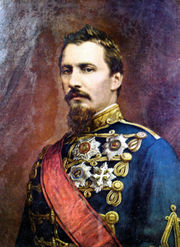
During the period of Austro-Hungarian rule in Transylvania, and Ottoman suzerainty over Wallachia and Moldavia, most Romanians were in the situation of being second-class citizens (or even non-citizens)[44] in a territory where they formed the majority of the population.[45][46] In some Transylvanian cities, such as Braşov (at that time the Transylvanian Saxon citadel of Kronstadt), Romanians were not even allowed to reside within the city walls.[47]
After the failed 1848 Revolution, the Great Powers did not support the Romanians' expressed desire to officially unite in a single state, which forced Romania to proceed alone against the Ottomans. The electors in both Moldavia and Wallachia chose in 1859 the same person –Alexandru Ioan Cuza– as prince (Domnitor in Romanian).[48]
Thus, Romania was created as a personal union, albeit a Romania that did not include Transylvania. There, the upper class and the aristocracy remained mainly Hungarian, and Romanian nationalism inevitably ran up against Hungarian in the late 19th century. As in the previous 900 years, Austria-Hungary, especially under the Dual Monarchy of 1867, kept the Hungarians firmly in control even in the parts of Transylvania where Romanians constituted a local majority.
In a 1866 coup d'état, Cuza was exiled and replaced by Prince Karl of Hohenzollern-Sigmaringen, who became known as Prince Carol of Romania. During the Russo-Turkish War Romania fought on the Russian side,[49] and in the 1878 Treaty of Berlin, Romania was recognized as an independent state by the Great Powers.[50][51] In return, Romania ceded three southern districts of Bessarabia to Russia and acquired Dobruja. In 1881, the principality was raised to a kingdom and Prince Carol became King Carol I.
The 1878–1914 period was one of stability and progress for Romania. During the Second Balkan War, Romania joined Greece, Serbia, Montenegro and Turkey against Bulgaria, and in the peace Treaty of Bucharest (1913) Romania gained Southern Dobrudja.[52]
World Wars and Greater Romania
- (1916–1945)
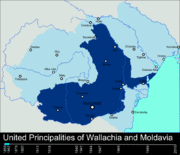

The first two years of the World War I saw a neutral Romania, as its nominal alliance with the Central Powers stated Romania was to oblige only in the event Austro-Hungarian Empire was attacked; while Romania's demands of recognition of its right to annex territories of Austria-Hungary with a Romanian populace were accepted by the Entente only in 1916 in the Treaty of Bucharest.
The Romanian military campaign launched in August 1916 was largely unsuccessful, with Central Powers troops capturing Bucharest and occupying Wallachia and Dobrudja, the Romanian Army and the Russian Imperial Army defending Moldova until December 1917. The collapse of the Russian Empire during 1917 and the disbandment of its army left Romania isolated and surrounded on the Eastern Front, and an armistice with the Central Powers was signed in December 1917.
The National Council of the Moldavian Democratic Republic proclaimed union with Romania on 27 March 1918. Between May and July 1918, The Treaty of Bucharest was underway between German Empire and Romania with harsh conditions for Romania, and King Ferdinand of Romania refused to ratify it. The Hundred Days Offensive during the summer of 1918, meant the defeat of Germany and Austria-Hungary on the Western and Italian fronts, allowing Romania to renounce the treaty in October 1918. Romania re-entered the war on November 10, 1918. The next day, the Treaty of Bucharest was nullified by the terms of the Armistice of Compiègne. On November 15, 1918 Bukovina proclaimed union with Romania. The National Assembly of the Romanians of Transylvania proclaimed union with Romania on December 1, 1918.
The ensuing Hungarian–Romanian War of 1919 led to the destruction of the Hungarian Soviet Republic.
The Treaty of Trianon ratified in 1920, established Transylvania under sovereignty of Kingdom of Romania. The union of Bukovina with Romania was ratified in 1919 in the Treaty of Saint Germain,[53] and the union of Bessarabia with Romania in 1920 by the Treaty of Paris.[54]
Total Romanian World War I casualties from 1914 to 1918, military and civilian, within contemporary borders, were estimated at 748,000.[55]
The Romanian expression România Mare (literal translation "Great Romania", but more commonly rendered "Greater Romania") generally refers to the Romanian state in the interwar period, and by extension, to the territory Romania covered at the time (see map). Romania achieved at that time its greatest territorial extent (almost 300,000 km2/120,000 sq mi).[56][56]

Romania remained neutral after the start of the World War II in September 1939. The Battle of France rendered its allies France and Britain unable to help, and on June 28, 1940, following the Soviet ultimatum which implied invasion in the event of non-compliance[57] the Romanian administration and the Army withdrew from Bessarabia as well from Northern Bukovina and Hertza.[58] Further Axis pressure lead to more territorial losses for Romania: southern Dobrogea was ceded to Bulgaria and Northern Transylvania to Hungary through the Second Vienna Award.[59]
The socio-political turmoil resulted in the abdication of Carol II of Romania, and the installment the National Legionary State, in which power was shared by General Ion Antonescu and the Iron Guard. Tensions between the two led to a Legionary Rebellion which was promptly crushed by the Army, and Antonescu established his own dictatorship, allying Romania with Nazi Germany. In 1941 Romania entered the war against the Soviet Union on the side of the Axis powers.
During the war, Romania was the most important source of oil for Germany,[60] which attracted multiple bombing raids by the Allies. The Romanian Army made a major contribution to the Axis effort on the Eastern Front, retaking Bessarabia and Northern Bukovina and participating in major battles at Odessa, Sevastopol and Stalingrad. The Antonescu regime played a major role in the Holocaust,[61] following to a lesser extent the Nazi policy of oppression and massacre of the Jews, and Romanies, primarily in the Eastern territories Romania recovered or occupied from the Soviet Union (Transnistria) and in Moldavia.[62]
In August 1944, Antonescu was toppled and arrested by King Michael I of Romania. Romania joined the Allies, but its role in the defeat of Nazi Germany was not recognized by the Paris Peace Conference of 1947.[63] By the end of the war, the Romanian Army had suffered about 519,000 casualties.[64] The Paris Peace Treaties, 1947 rendered the Vienna Diktat void, and re-established Romania's western borders. Northern Bukovina and Bessarabia remained occupied by the USSR. By 1948 the pre-war German population of 780,000 had been reduced by more than half.[65]
Jewish Holocaust victims totaled 469,000 within the 1939 borders, including 325,000 in Bessarabia and Bukovina.[66]
Communism
- (1945–1989)
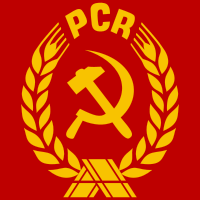
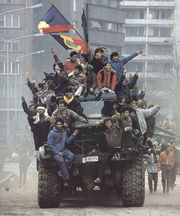
During the Soviet occupation of Romania, the Communist-dominated government called new elections, which were won with 80% of the vote through intimidation and probable electoral fraud.[67] They thus rapidly established themselves as the dominant political force.
In 1947, the Communists forced King Michael I to abdicate and leave the country, and proclaimed Romania a people's republic.[68][69] Romania remained under the direct military occupation and economic control of the USSR until the late 1950s. During this period, Romania's vast natural resources were continuously drained[70] by mixed Soviet-Romanian companies (SovRoms) set up for exploitative purposes.[71][72] In 1948, the state began to nationalize private firms (see nationalization in Romania), and to collectivize agriculture the following year (see collectivization in Romania).[73]
From the late 1940s to the early 1960s, the Communist government established a reign of terror, carried out mainly through the Securitate (the new secret police). During this time they launched several campaigns to eliminate "enemies of the state", in which numerous individuals were killed or imprisoned for arbitrary political or economic reasons.[74] Punishment included deportation, internal exile, and internment in forced labour camps and prisons; dissent was vigorously suppressed. A notorious experiment in this period took place in the Piteşti prison, where a group of political opponents were put into a program of reeducation through torture. Historical records show hundreds of thousands of abuses, deaths and incidents of torture against a wide range of people, from political opponents to ordinary citizens.[75]
In 1965, Nicolae Ceauşescu came to power and started to pursue independent policies such as being the only Warsaw Pact country to condemn the Soviet-led 1968 invasion of Czechoslovakia, and to continue diplomatic relations with Israel after the Six-Day War of 1967; establishing economic (1963) and diplomatic (1967) relations with the Federal Republic of Germany.[76] Also, close ties with the Arab countries (and the PLO) allowed Romania to play a key role in the Israel–Egypt and Israel–PLO peace processes.[77]
But as Romania's foreign debt sharply increased between 1977 and 1981 (from 3 to 10 billion US dollars),[78] the influence of international financial organisations such as the IMF or the World Bank grew, conflicting with Nicolae Ceauşescu's autarchic policies. He eventually initiated a project of total reimbursement of the foreign debt by imposing policies that impoverished Romanians and exhausted the Romanian economy, while also greatly extending the authority of the police state, and imposing a cult of personality. These led to a dramatic decrease in Ceauşescu's popularity and culminated in his overthrow and execution in the bloody Romanian Revolution of 1989.
In 2006, the Presidential Commission for the Study of the Communist Dictatorship in Romania estimated the number of direct victims of communist repression at two million people.[79][80] This number does not include people who died in liberty as a result of their treatment in communist prisons, nor does it include people who died because of the dire economic circumstances in which the country found itself.
Present-day democracy
After the revolution, the National Salvation Front, led by Ion Iliescu, took partial multi-party democratic and free market measures.[81][82] Several major political parties of the pre-war era, such as the Christian-Democratic National Peasants' Party, the National Liberal Party and the Romanian Social Democrat Party were resurrected. After several major political rallies, in April 1990, a sit-in protest contesting the results of the recently held parliamentary elections began in University Square, Bucharest accusing the Front of being made up of former Communists and members of the Securitate.
The protesters did not recognize the results of the election, deeming them undemocratic, and asked for the exclusion from the political life of the former high-ranking Communist Party members. The protest rapidly grew to become an ongoing mass demonstration (known as the Golaniad). The peaceful demonstrations degenerated into violence, and the violent intervention of coal miners from the Jiu Valley led to what is remembered as the June 1990 Mineriad.[83]
The subsequent disintegration of the Front produced several political parties including the Romanian Democrat Social Party (later Social Democratic Party), the Democratic Party and the (Alliance for Romania). The first governed Romania from 1990 until 1996 through several coalitions and governments and with Ion Iliescu as head of state. Since then there have been four democratic changes of government: in 1996, the democratic-liberal opposition and its leader Emil Constantinescu acceded to power; in 2000 the Social Democrats returned to power, with Iliescu once again president; and in 2004 Traian Băsescu was elected president, with an electoral coalition called Justice and Truth Alliance. Băsescu was narrowly re-elected in 2009.[84]
Post-Cold War Romania developed closer ties with Western Europe, eventually joining NATO in 2004, and hosting the 2008 summit in Bucharest.[85] The country applied in June 1993 for membership in the European Union and became an Associated State of the EU in 1995, an Acceding Country in 2004, and a member on January 1, 2007.[86]
Following the free travel agreement and politics of the post-Cold War period, as well as hardship of the life in the 1990s economic depression, Romania has an increasingly large diaspora, estimated at over 2 million people. The main emigration targets are Spain, Italy, Germany, Austria, UK, Canada and the USA.[87]
During the 2000s, Romania enjoyed one of the highest economic growth rates in Europe and has been referred to as "the Tiger of Eastern Europe."[88] This has been accompanied by a significant improvement in human development.[89] The country has been successful in reducing internal poverty and establishing a functional democracy.[90] However, Romania still faces issues related to infrastructure,[91] medical services,[92] education,[93] and corruption.[94]
Geography
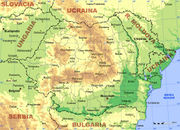
With a surface area of 238,391 square kilometres (92,043 sq mi), Romania is the largest country in southeastern Europe and the twelfth-largest in Europe.[95] A large part of Romania's border with Serbia and Bulgaria is formed by the Danube. The Danube is joined by the Prut River, which forms the border with the Republic of Moldova.[95] The Danube flows into the Black Sea within Romania's territory forming the Danube Delta, the second largest and the best preserved delta in Europe, and a biosphere reserve and a biodiversity World Heritage Site.[96] Other important rivers are the Siret, running north-south through Moldavia, the Olt, running from the oriental Carpathian Mountains to Oltenia, and the Mureş, running through Transylvania from East to West.[95]
Romania's terrain is distributed roughly equally between mountainous, hilly and lowland territories. The Carpathian Mountains dominate the centre of Romania, with fourteen of its mountain ranges reaching above the altitude of 2,000 meters.[95] The highest mountain in Romania is Moldoveanu Peak (2,544 m/8,346 ft). In south-central Romania, the Carpathians sweeten into hills, towards the Bărăgan Plains. Romania's geographical diversity has led to an accompanying diversity of flora and fauna.[95]
Environment
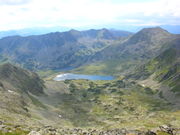
A high percentage (47% of the land area) of the country is covered with natural and semi-natural ecosystems.[97] Since almost half of all forests in Romania (13% of the country) have been managed for watershed conservation rather than production, Romania has one of the largest areas of undisturbed forest in Europe.[97] The integrity of Romanian forest ecosystems is indicated by the presence of the full range of European forest fauna, including 60% and 40% of all European brown bears and wolves, respectively.[98] There are also almost 400 unique species of mammals (of which Carpathian chamois are best known), birds, reptiles and amphibians in Romania.[99]
There are almost 10,000 km2 (3,900 sq mi) (almost 5% of the total area) of protected areas in Romania.[100] Of these, Danube Delta Reserve Biosphere is the largest and least damaged wetland complex in Europe, covering a total area of 5,800 km2 (2,200 sq mi).[101] The significance of the biodiversity of the Danube Delta has been internationally recognised. It was declared a Biosphere Reserve in September 1990, a Ramsar site in May 1991, and over 50% of its area was placed on the World Heritage List in December 1991.[102] Within its boundaries lies one of the most extensive reed bed systems in the world.[103] There are two other biosphera reserves: Retezat National Park and Rodna National Park.
Flora and fauna
In Romania there have been identified 3,700 plant species from which to date 23 have been declared natural monuments, 74 missing, 39 are endangered, 171 vulnerable and 1,253 are considered rare.[104] The three major vegetation areas in Romania are the alpine zone, the forest zone and the steppe zone. The vegetation is distributed in an storied manner in accordance with the characteristics of soil and climate, but according to altitude as: oak, sycamore, linden, ash (in the steppe zone and low hills), beech, oak (between 500 and 1200 meters), spruce, fir, pine (between 1200 and 1800 m), juniper, Mountain Pine and dwarf trees (in 1800 and 2000 meters), alpine meadows consisting of small herbs (over 2000 meters).[105][106] Off the high valleys, due to persistent moisture, there is a specific vegetation of meadow, reed, rush, sedge, and often with patches of willows, poplars and Arini. In the Danube Delta swamp vegetation is dominant.[105]
The fauna of Romania consists of 33,792 species of animals, 33,085 invertebrate and 707 vertebrate.[104] The vertebrate species consist of 191 fish, 20 amphibian, 30 reptile, 364 bird and 102 mammal species.[104] Fauna is especially broken down by vegetation. Thus, specific floor steppe and forest steppe have the following species: rabbit, hamster, ground squirrel, pheasant, great bustard, quail, carp, perch, pike, catfish, the forest floor of hardwood (oak and beech): boar, wolf, fox, barbel, woodpecker, and for coniferous forest floor: trout, lynx, deer, goats and specific alpine fauna like black and golden eagles.[105][106] In particular the Danube Delta is the place where hundreds of species of birds exist, including pelicans, swans, wild geese and flamingos, birds that are protected by law. The delta is also a seasonal stopover for migratory birds. Some rare species of birds in the Dobrogea area are the pelican, cormorant, little deer, Red-breasted Goose, White-fronted Goose and the Mute Swan.[107]
Climate
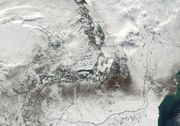
Owing to its distance from the open sea and position on the southeastern portion of the European continent, Romania has a climate that is transitional between temperate and continental with four distinct seasons. The average annual temperature is 11 °C (52 °F) in the south and 8 °C (46 °F) in the north.[108] The extreme recorded temperatures are 44.5 °C (112.1 °F) in Ion Sion 1951 and −38.5 °C (−37.3 °F) in Bod 1942.[109]
Spring is pleasant with cool mornings and nights and warm days. Summers are generally very warm to hot, with summer (June to August) average maximum temperatures in Bucharest being around 28 °C (82 °F), with temperatures over 35 °C (95 °F) fairly common in the lower-lying areas of the country. Minima in Bucharest and other lower-lying areas are around 16 °C (61 °F), but at higher altitudes both maxima and minima decline considerably. Autumn is dry and cool, with fields and trees producing colorful foliage. Winters can be cold, with average maxima even in lower-lying areas being no more than 2 °C (36 °F) and below −15 °C (5.0 °F) in the highest mountains, where some areas of permafrost occur on the highest peaks.[110]
Precipitation is average with over 750 mm (30 in) per year only on the highest western mountains — much of it falling as snow which allows for an extensive skiing industry. In the south-central parts of the country (around Bucharest) the level of precipitation drops to around 600 mm (24 in),[111] while in the Danube Delta, rainfall levels are very low, and average only around 370 mm.
Demographics
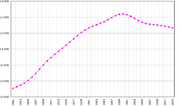
In 2002, Romania had a population of 21,698,181. Like other countries in the region, its population is expected to gradually decline in the coming years as a result of sub-replacement fertility rates. Romanians make up 89.5% of the population. The largest ethnic minorities are the Szekelys and Hungarians, who make up 6.6% of the population and Roma (Gypsies), who make up 2.46% of the population.[note 4][112]
Hungarians constitute a majority in the counties of Harghita and Covasna. Ukrainians, Germans, Lipovans, Turks, Tatars, Serbs, Slovaks, Bulgarians, Croats, Greeks, Russians, Jews, Czechs, Poles, Italians, Armenians, as well as other ethnic groups, account for the remaining 1.4% of the population.[113]
In 1930 there were 745,421 Germans in Romania in 1930,[114] but only about 60,000 remain today.[115] In 1924, there were 796,056 Jews in the Kingdom of Romania.[116] The number of Romanians and individuals with ancestors born in Romania living abroad is estimated at around 12 million.[87] As of 2009, there were also approximately 133,000 immigrants living in Romania,[89] primarily from Moldova, Turkey and China.
Languages
The official language of Romania is Romanian, an Eastern Romance language related to Italian, French, Spanish, Portuguese and Catalan. Romanian is spoken as a first language by 91% of the population. Hungarian and Romani are the most important minority languages, spoken by 6.7% and 1.1% of the population, respectively.[113] Until the 1990s, there was also a substantial number of German-speaking Transylvanian Saxons, even though many have since emigrated to Germany, leaving only 45,000 native German speakers in Romania.
In localities where a given ethnic minority makes up more than 20% of the population, that minority's language can be used in the public administration and justice system, while native-language education and signage is also provided. English and French are the main foreign languages taught in schools. English is spoken by 5 million Romanians, French is spoken by 4–5 million, and German, Italian and Spanish are each spoken by 1–2 million people.[117]
Historically, French was the predominant foreign language spoken in Romania, but English has since superseded it. Consequently, Romanian English-speakers tend to be younger than Romanian French-speakers. Romania is, however, a full member of La Francophonie, and hosted the Francophonie Summit in 2006.[118] German has been taught predominantly in Transylvania, due to traditions tracing back to the Austro-Hungarian rule in this province.
Religion
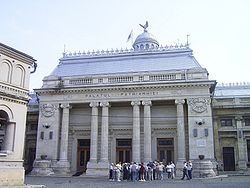
Romania is a secular state, thus having no national religion. The dominant religious body is the Romanian Orthodox Church, an autocephalous church within the Eastern Orthodox communion; its members make up 86.7% of the population according to the 2002 census. Other important Christian denominations include Roman Catholicism (4.7%), Protestantism (3.7%), Pentecostalism (1.5%) and the Romanian Greek-Catholic Church (0.9%).[113]
Romania also has a Muslim minority concentrated in Dobrogea, mostly of Turkish ethnicity and numbering 67,500 people.[119] According to the results of the 2002 census, there are 66,846 Romanian citizens of the Unitarian faith (0.3% of the total population). Church officials place the number of believers at 80,000-100,000.[2] Of the total Hungarian-speaking minority in Romania, Unitarians represent 4.55%, being the third denominational group after members of the Reformed Church in Romania (47.10%) and Roman Catholics (41.20%). Since 1700, the Unitarian Church has had 125 parishes — in 2006, there were 110 Unitarian ministers and 141 places of worship in Romania. According to the 2002 census, there were 6,179 Jews, 23,105 people who are of no religion and/or atheist, and 11,734 who refused to answer. On December 27, 2006, a new Law on Religion was approved under which religious denominations can only receive official registration if they have at least 20,000 members, or about 0.1% of Romania's total population.[120]
Largest cities
Bucharest is the capital and the largest city in Romania. At the census in 2002, its population was over 1.9 million.[121] The metropolitan area of Bucharest has a population of about 2.2 million. There are several plans to increase further its metropolitan area to about 20 times the area of the city proper.[122][123]
Romania has five other cities that are among the European Union's 100 most populous. These are Iaşi, Timişoara, Cluj-Napoca, Constanţa, and Craiova. The other cities with populations over 200,000 are Galaţi, Braşov, Ploieşti, Brăila and Oradea. Another 13 cities have a population of over 100,000.[5]
At present, several of the largest cities have a metropolitan area: Constanţa (450,000 people), Braşov, Iaşi (both with around 400,000), Cluj-Napoca (380,000), Craiova (335,000) and Oradea (260,000), and several others are planned: Timişoara, Brăila-Galaţi, Bacău and Ploieşti.[124]
Education

Since the Romanian Revolution of 1989, the Romanian educational system has been in a continuous process of reform that has been both praised and criticized.[125] According to the Law on Education adopted in 1995, the educational system is regulated by the Ministry of Education and Research. Each level has its own form of organization and is subject to different legislation. Kindergarten is optional for children between 3 and 6 years old. Schooling starts at age 7 (sometimes 6), and is compulsory until the 10th grade (which usually corresponds to the age of 17 or 16).[126] Primary and secondary education are divided into 12 grades. Higher education is aligned with the European higher education area.
Aside from the official schooling system, and the recently added private equivalents, there exists a semi-legal, informal, fully private tutoring system. Tutoring is mostly used during secondary as a preparation for the various examinations, which are notoriously difficult. Tutoring is widespread, and it can be considered a part of the Education System. It has subsisted and even prospered during the Communist regime.[127]
In 2004, some 4.4 million of the population were enrolled in school. Out of these, 650,000 in kindergarten, 3.11 million (14% of population) in primary and secondary level, and 650,000 (3% of population) in tertiary level (universities).[128] In the same year, the adult literacy rate was 97.3% (45th worldwide), while the combined gross enrollment ratio for primary, secondary and tertiary schools was 75% (52nd worldwide).[129]
The results of the PISA assessment study in schools for the year 2000 placed Romania on the 34th rank out of 42 participant countries with a general weighted score of 432 representing 85% of the mean OECD score.[130] According to the Academic Ranking of World Universities, in 2006 no Romanian university was included in the first 500 top universities world wide.[131] Using similar methodology to these rankings, it was reported that the best placed Romanian university, Bucharest University, attained the half score of the last university in the world top 500.[132] Notably, Bucharest boasts the largest university in Europe by number of students, Spiru Haret University.[133]
Government
Politics
The Constitution of Romania is based on the Constitution of France's Fifth Republic[134] and was approved in a national referendum on December 8, 1991.[134] A plebiscite held in October 2003 approved 79 amendments to the Constitution, bringing it into conformity with European Union legislation.[134] Romania is governed on the basis of multi-party democratic system and of the segregation of the legislative, executive and judicial powers.[134] Romania is a semi-presidential democratic republic where executive functions are shared between the president and the prime minister. The President is elected by popular vote for maximum two terms, and since the amendments in 2003, the terms are five years.[134] The President appoints the Prime Minister, who in turn appoints the Council of Ministers.[134] While the president resides at Cotroceni Palace, the Prime Minister with the Romanian Government is based at Victoria Palace.
The legislative branch of the government, collectively known as the Parliament (Parlamentul României), consists of two chambers – the Senate (Senat), which has 140 members, and the Chamber of Deputies (Camera Deputaţilor), which has 346 members.[134] The members of both chambers are elected every four years under a system of party-list proportional representation.[134]
The justice system is independent of the other branches of government, and is made up of a hierarchical system of courts culminating in the High Court of Cassation and Justice, which is the supreme court of Romania.[135] There are also courts of appeal, county courts and local courts. The Romanian judicial system is strongly influenced by the French model,[134][136] considering that it is based on civil law and is inquisitorial in nature. The Constitutional Court (Curtea Constituţională) is responsible for judging the compliance of laws and other state regulations to the Romanian Constitution, which is the fundamental law of the country. The constitution, which was introduced in 1991, can only be amended by a public referendum, the last one being in 2003. Since this amendment, the court's decisions cannot be overruled by any majority of the parliament.
The country's entry into the European Union in 2007[137] has been a significant influence on its domestic policy. As part of the process, Romania has instituted reforms including judicial reform, increased judicial cooperation with other member states, and measures to combat corruption. Nevertheless, in 2006 Brussels report, Romania and Bulgaria were described as the two most corrupt countries in the EU,[138] and it was ranked as the most corrupt EU country by Transparency International in 2009, alongside Bulgaria and Greece.[139]
Administrative divisions
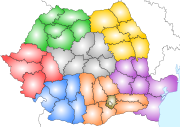
Romania is divided into forty-one counties (sing. judeţ, pl. judeţe), plus the municipality of Bucharest (Bucureşti) – which has equal rank. Each county is administered by a county council (consiliu judeţean), responsible for local affairs, as well as a prefect, who is appointed by the central government but cannot be a member of any political party, responsible for the administration of national (central) affairs at the county level. Since 2008, the president of the county council (preşedintele consiliului judeţean) is directly elected by the people, and not by the county council as before that.[140]
Each county is further subdivided into cities (sing. oraş, pl. oraşe) and communes (sing. comună, pl. comune), the former being urban, and the latter being rural localities. There are a total of 319 cities and 2686 communes in Romania.[141] Each city and commune has its own mayor (primar) and local council (consiliu local). 103 of the larger and more urbanised cities have the status of municipality, which gives them greater administrative power over local affairs. Bucharest is also reckoned as a city with municipality status, but it is unique among the other localities in that it is not part of a county. It does not have a county concil, but has a prefect. Bucharest elects a general mayor (primar general) and a general city council (Consiliul General Bucureşti). Each of Bucharest's six sectors also elects a mayor and a local council.[141]
The NUTS-3 level divisions reflect Romania's administrative-territorial structure, and correspond to the 41 counties, and the Bucharest municipality.[142] Cities and communes are NUTS-5 level divisions. The country currently does not have NUTS-4 level divisions, but there are plans to make such associating neighbouring localities for better coordination of local development and assimilation of national and European funds.[142]
The 41 counties and Bucharest are grouped into eight development regions corresponding to NUTS-2 divisions in the European Union.[142] Prior to Romania's accession into the European Union, these were called statistical regions, and were used exclusively for statistical purposes. Thus, albeit they formally existed for over 40 years, the regions are publicly a news. There are proposals in the future to cancel county councils (but leave the prefects) and create regional councils instead. This would not change the nomenclature of the country's territorial subdivision, but would presumably allow better coordination of policy at the local level, more autonomy, and a smaller bureaucracy.[142]
There are also proposals to use four NUTS-1 level divisions; they would be called macroregions (Romanian:Macroregiune). NUTS-1 and -2 divisions have no administrative capacity and are instead used for co-ordinating regional development projects and statistical purposes.[142]
- Macroregiunea 1:[142]
- Nord-Vest (6 counties: Bihor, Bistriţa-Năsăud, Cluj, Maramureş, Satu Mare, Sălaj; roughly northern Transylvania)
- Centru (6 counties: Alba, Braşov, Covasna, Harghita, Mureş, Sibiu; roughly southern Transylvania)
- Macroregiunea 2:[142]
- Macroregiunea 3:[142]
- Sud (7 counties: Argeş, Călăraşi, Dâmboviţa, Giurgiu, Ialomiţa, Prahova, Teleorman; the core of Muntenia)
- Bucureşti (Ilfov County and Bucharest)
- Macroregiunea 4:[142]
- Sud-Vest (5 counties: Dolj, Gorj, Mehedinţi, Olt, Vâlcea; roughly Oltenia)
- Vest (4 counties: Arad, Caraş-Severin, Hunedoara, Timiş; southwestern Transylvania, or Banat plus Arad and Hunedoara counties)
Foreign relations
Since December 1989, Romania has pursued a policy of strengthening relations with the West in general, more specifically with the United States and the European Union. It joined the North Atlantic Treaty Organisation (NATO) on March 29, 2004, the European Union (EU) on January 1, 2007, and the International Monetary Fund and the World Bank in 1972, and is a founder member of the World Trade Organization.
The current government has stated its goal of strengthening ties with and helping other Eastern European countries (in particular Moldova, Ukraine and Georgia) with the process of integration with the West.[143] Romania has also made clear since the late 1990s that it supports NATO and EU membership for the democratic former Soviet republics in Eastern Europe and the Caucasus.[143] Romania also declared its public support for Turkey, Croatia and Moldova joining the European Union.[143] With Turkey, Romania shares a privileged economic relation.[144] Because it has a large Hungarian minority, Romania has also developed strong relations with Hungary – the latter supported Romania's bid to join the EU.[145]
In December 2005, President Traian Băsescu and United States Secretary of State Condoleezza Rice signed an agreement that would allow a U.S. military presence at several Romanian facilities primarily in the eastern part of the country.[146] In May 2009, U.S. Secretary of State Hillary Clinton declared that "Romania is one of the most trustworthy and respectable partners of the USA" during a visit of the Romanian foreign minister.[147]
Relations with The Republic of Moldova are special,[143] considering that the two countries practically share the same language, and a fairly common historical background. A movement for unification of Romania and Moldova appeared in the early 1990s after both countries achieved emancipation from communist rule,[148] but quickly faded away with the new Moldovan government that had an agenda to preserve a Moldovan republic independent of Romania.[149] Romania remains interested in Moldovan affairs and has officially rejected the Molotov-Ribbentrop Pact,[148] but the two countries have been unable even to reach agreement on a basic bilateral treaty.[150]
Armed Forces
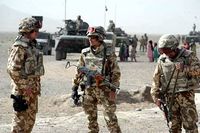

The Romanian Armed Forces consist of Land, Air, and Naval Forces, and are led by a Commander-in-chief who is managed by the Ministry of Defense. The president is the Supreme Commander of the Armed Forces during wartime. Of the 90,000 men and women which the Armed Forces comprise, 15,000 are civilians and 75,000 are military personnel—45,800 for land, 13,250 for air, 6,800 for naval forces, and 8,800 in other fields.[151]
The total defence spending currently accounts for 2.05% of total national GDP, which represents approximately 2.9 billion dollars (ranked 39th). However, the Romanian Armed Forces will spend about 11 billion dollars between 2006 and 2011, for modernization and acquisition of new equipment.[152] The Land Forces have overhauled their equipment in the past few years, and today are an army with multiple NATO capabilities, participating in a NATO peacekeeping mission in Afghanistan.
The Air Force currently operates modernized Soviet MiG-21LanceR fighters which could be replaced by refurbished F-16 Fighting Falcon jet fighters.[153] Also, in order to replace the bulk of the old transport force, the Air Force ordered seven new C-27J Spartan tactical airlift aircraft which are to be delivered starting with late 2008.[154] Two modernized ex-Royal Navy Type 22 frigates were acquired by the Naval Forces in 2004, and a further four modern missile corvettes will be commissioned until 2010.
Economy
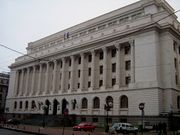
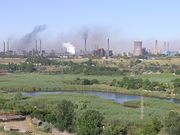
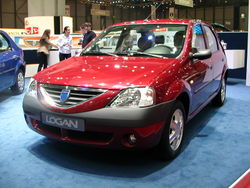
With a GDP of around $271 billion and a GDP per capita (PPP) of $12,600[157] for the year 2008, Romania is an upper-middle income country economy[158] and has been part of the European Union since January 1, 2007. After the Communist regime was overthrown in late 1989, the country experienced a decade of economic instability and decline, led in part by an obsolete industrial base and a lack of structural reform. From 2000 onwards, however, the Romanian economy was transformed into one of relative macroeconomic stability, characterised by high growth, low unemployment and declining inflation. In 2006, according to the Romanian Statistics Office, GDP growth in real terms was recorded at 7.7%, one of the highest rates in Europe.[159] Growth dampened to 6.1% in 2007,[160] but was expected to exceed 8% in 2008 because of a high production forecast in agriculture (30–50% higher than in 2007). The GDP grew by 8.9% in the first nine months of 2008, but growth fell to 2.9% in the fourth quarter and stood at 7.1% for the whole 2008 because of the financial crisis.[161]
According to Eurostat data, the Romanian PPS GDP per capita stood at 46% of the EU average in 2008.[162] Unemployment in Romania was at 3.9% in September 2007,[163] which is very low compared to other middle-sized or large European countries such as Poland, France, Germany and Spain. Foreign debt is also comparatively low, at 20.3% of GDP.[164] Exports have increased substantially in the past few years, with a 25% year-on-year rise in exports in the first quarter of 2006. Romania's main exports are clothing and textiles, industrial machinery, electrical and electronic equipment, metallurgic products, raw materials, cars, military equipment, software, pharmaceuticals, fine chemicals, and agricultural products (fruits, vegetables, and flowers). Trade is mostly centred on the member states of the European Union, with Germany and Italy being the country's single largest trading partners. The country, however, maintains a large trade deficit, which increased sharply during 2007 by 50%, to €15 billion.[165]
After a series of privatisations and reforms in the late 1990s and early 2000s, government intervention in the Romanian economy is somewhat lower than in other European economies.[166] In 2005, the government replaced Romania's progressive tax system with a flat tax of 16% for both personal income and corporate profit, resulting in the country having the lowest fiscal burden in the European Union,[167] a factor which has contributed to the growth of the private sector. The economy is predominantly based on services, which account for 55% of GDP, even though industry and agriculture also have significant contributions, making up 35% and 10% of GDP, respectively. Additionally, 32% of the Romanian population is employed in agriculture and primary production, one of the highest rates in Europe.[164]
Since 2000, Romania has attracted increasing amounts of foreign investment, becoming the single largest investment destination in Southeastern and Central Europe. Foreign direct investment was valued at €8.3 billion in 2006.[168] According to a 2006 World Bank report, Romania currently ranks 55th out of 175 economies in the ease of doing business, scoring higher than other countries in the region such as the Czech Republic.[169] Additionally, the same study judged it to be the world's second-fastest economic reformer (after Georgia) in 2006.[170]
The average gross wage per month in Romania was 1855 lei in May 2009,[171] equating to €442.48 (US$627.70) based on international exchange rates, and $1110.31 based on purchasing power parity.[172] In 2009 the Romanian economy contracted as a result of the global economic downturn. Gross domestic product contracted 7.2% in the fourth quarter of 2009 from the same period a year earlier,[173] and the budget deficit for 2009 reached 7.2% of GDP.[174] Industrial output growth however reached 6.9% year-on-year in December 2009, the highest in the EU-27.[175]
Transportation
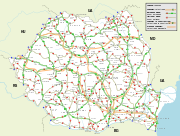
Due to its location, Romania is a major crossroad for International economic exchange in Europe. However, because of insufficient investment, maintenance and repair, the transport infrastructure does not meet the current needs of a market economy and lags behind Western Europe.[176] Nevertheless, these conditions are rapidly improving and catching up with the standards of Trans-European transport networks. Several projects have been started with funding from grants from ISPA and several loans from International Financial Institutions (World Bank, IMF, etc.) guaranteed by the state, to upgrade the main road corridors. Also, the Government is actively pursuing new external financing or public-private partnerships to further upgrade the main roads, and especially the country's motorway network.[176]
The World Bank estimates that the railway network in Romania comprised 22,298 kilometres (13,855 mi) of track in 2004, which would make it the fourth largest railroad network in Europe.[177] The railway transport experienced a dramatic fall in freight and passenger volumes from the peak volumes recorded in 1989 mainly due to the decline in GDP and competition from road transport. In 2004, the railways carried 8.64 billion passenger-km in 99 million passenger journeys, and 73 million metric tonnes, or 17 billion ton-km of freight.[134] The combined total transportation by rail constituted around 45% of all passenger and freight movement in the country.[134]
Bucharest is the only city in Romania which has an underground railway system. The Bucharest Metro was only opened in 1979 and is now one of the most accessed systems of the Bucharest public transport network with an average ridership of 600,000 passengers during the workweek.[178]
Tourism
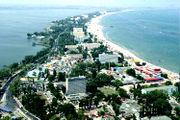
Tourism focuses on the country's natural landscapes and its rich history and is a significant contributor to the Romania's economy. In 2006, the domestic and international tourism generated about 4.8% of gross domestic product and 5.8% of the total jobs (about half a million jobs).[179] Following commerce, tourism is the second largest component of the services sector. Tourism is one of the most dynamic and fastest developing sectors of the economy of Romania and characterized by a huge potential for development.
According to the World Travel and Tourism Council Romania is the fourth fastest growing country in the world in terms of travel and tourism total demand with a yearly potential growth of 8% from 2007-2016.[180] Number of tourists grew from 4.8 million in 2002 to 6.6 million in 2004.[134] Similarly, the revenues grew from 400 million in 2002 to 607 in 2004.[134] In 2006, Romania registered 20 million overnight stays by international tourists, an all-time record,[181] but the number for 2007 is expected to increase even more.[182] Tourism in Romania attracted €400 million in investments in 2005.[183]
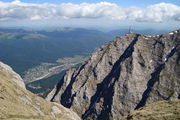
Over the last years, Romania has emerged as a popular tourist destination for many Europeans (more than 60% of the foreign visitors were from EU countries),[182] thus attempting to compete with Bulgaria, Greece, Italy and Spain. Romania destinations such as Mangalia, Saturn, Venus, Neptun, Olimp, Constanta and Mamaia (sometimes called the Romanian Riviera) are among the most popular attraction during summer.[184] During winter, the skiing resorts along the Valea Prahovei and Poiana Braşov are popular with foreign visitors.
For their medieval atmosphere and castles, Transylvanian cities such as Sibiu, Braşov, Sighişoara, Cluj-Napoca, Târgu Mureş have become important touristic attractions for foreigners. Rural tourism focused on folklore and traditions, has become an important alternative recently,[185] and is targeted to promote such sites as Bran and its Dracula's Castle, the Painted churches of Northern Moldavia, the Wooden churches of Maramureş, or the Merry Cemetery in Maramureş County.[186] Other major natural attractions in Romania such as Danube Delta,[134] Iron Gates (Danube Gorge), Scărişoara Cave and several other caves in the Apuseni Mountains have yet to receive great attention.
Culture
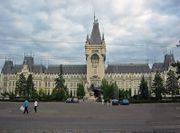
Romania has a unique culture, which is the product of its geography and of its distinct historical evolution. Like Romanians themselves, it is fundamentally defined as the meeting point of three regions: Central Europe, Eastern Europe, and the Balkans, but cannot be truly included in any of them.[187] The Romanian identity formed on a substratum of mixed Roman and quite possibly Dacian elements,[188] with many other influences.
During late Antiquity and the Middle Ages, the major influences came from the Slavic peoples who migrated and settled in near Romania;[188] from medieval Greeks,[188] and the Byzantine Empire;[189] from a long domination by the Ottoman Empire;[190] from the Hungarians;[188] and from the Germans living in Transylvania. Modern Romanian culture emerged and developed over roughly the last 250 years under a strong influence from Western culture, particularly French,[189] and German culture.[189]
Arts
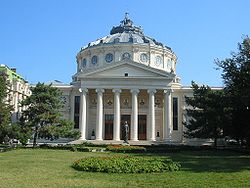
The Romanian literature began to truly evolve with the revolutions of 1848 and the union of the two Danubian Principalities in 1859. The Origin of the Romanians began to be discussed and in Transylvania and Romanian scholars began studying in France, Italy and Germany.[189] The German philosophy and French culture were integrated into modern Romanian literature and a new elite of artists led to the appearance of some of the classics of the Romanian literature such as Mihai Eminescu, George Coşbuc, Ioan Slavici.
Although they remain little known outside Romania, they are very appreciated within Romania for giving birth to a true Romanian literature by creating modern lyrics with inspiration from the old folklore tales. Of them, Eminescu is considered the most important and influential Romanian poet, and is still very much loved for his creations, and especially the poem Luceafărul.[191] Among other writers that made large contributions around the second half of 19th century are Mihail Kogălniceanu (also the first prime minister of Romania), Vasile Alecsandri, Nicolae Bălcescu, Ion Luca Caragiale, and Ion Creangă.
The first half of the 20th century is regarded by many Romanian scholars as the Golden Age of Romanian culture and it is the period when it reached its main level of international affirmation and a strong connection to the European cultural trends.[192] The most important artist who had a great influence on the world culture was the sculptor Constantin Brâncuşi, a central figure of the modern movement and a pioneer of abstraction, the innovator of world sculpture by immersion in the primordial sources of folk creation. His sculptures blend simplicity and sophistication that led the way for modernist sculptors.[193] As a testimony to his skill, one of his pieces, "Bird in Space" , was sold in an auction for $27.5 million in 2005, a record for any sculpture.[194][195]
In the period between the two world wars, authors like Tudor Arghezi, Lucian Blaga, Eugen Lovinescu, Ion Barbu, Liviu Rebreanu made efforts to synchronize Romanian literature with the European literature of the time. George Enescu, probably the best known Romanian musician, also came from this period;[196] a composer, violinist, pianist, conductor, and teacher,[197] the annual George Enescu Festival is held in Bucharest in his honor.

After the world wars, communism brought heavy censorship and used the cultural world as a means to better control the population. Freedom of expression was constantly restricted in various ways, but the likes of Gellu Naum, Nichita Stănescu, Marin Sorescu or Marin Preda managed to escape censorship, broke with "socialist realism" and were the leaders of a small "Renaissance" in Romanian literature.[198] While not many of them managed to obtain international acclaim due to censorship, some, like Constantin Noica, Paul Goma and Mircea Cărtărescu, had their works published abroad even though they were jailed for various political reasons.
Some artists chose to leave the country for good and continued to make contributions in exile. Among them Eugen Ionescu, Mircea Eliade and Emil Cioran became renowned internationally for their works. Other literary figures who enjoy acclaim outside of the country include the poet Paul Celan and Nobel laureate Elie Wiesel, both survivors of the Holocaust. Some famous Romanian musicians are the folk artists Maria Tanase, Tudor Gheorghe, and the virtuoso of the pan flute Gheorghe Zamfir – who is reported to have sold over 120 million albums worldwide.[199][200]
Romanian cinema has recently achieved worldwide acclaim with the appearance of such films as The Death of Mr. Lazarescu, directed by Cristi Puiu, (Cannes 2005 Prix un certain regard winner), and 4 Months, 3 Weeks and 2 Days, directed by Cristian Mungiu (Cannes 2007 Palme d'Or winner).[201] The latter, according to Variety, is "further proof of Romania's new prominence in the film world."[202]
Monuments
The UNESCO List of World Heritage Sites[203] includes Romanian sites such as the Saxon villages with fortified churches in Transylvania, the Painted churches of northern Moldavia with their fine exterior and interior frescoes, the Wooden Churches of Maramures unique examples that combine Gothic style with traditional timber construction, the Monastery of Horezu, the citadel of Sighişoara, and the Dacian Fortresses of the Orăştie Mountains.[204]
Romania's contribution to the World Heritage List stands out because it consists of some groups of monuments scattered around the country, rather than one or two special landmarks.[205] Also, in 2007, the city of Sibiu famous for its Brukenthal National Museum is the European Capital of Culture alongside the city of Luxembourg.
National Flag
The national flag of Romania is a tricolour with vertical stripes: beginning from the flagpole, blue, yellow and red. It has a width-length ratio of 2:3. Romania's national flag is very similar to that of Chad.[206][207][208]
Sports
Association football is the most popular sport in Romania.[209] The governing body is the Romanian Football Federation, which belongs to UEFA. The top division of the Romanian Professional Football League attracted an average of 5,417 spectators per game in the 2006–07 season.[210] At international level, the Romanian National Football Team has taken part 7 times in the Football World Cup, and it had the most successful period throughout the 1990s, when during the 1994 World Cup in the United States, Romania reached the quarter-finals and was ranked by FIFA on the 6th place.
The core player of this "Golden Generation"[211] and perhaps the best known Romanian player internationally is Gheorghe Hagi (nicknamed the Maradona of the Carpathians).[212] Famous currently active players are Adrian Mutu and Cristian Chivu. The most famous football club is Steaua Bucureşti, who in 1986 became the first Eastern European club ever to win the prestigious European Champions Cup title, and who played the final again in 1989. Another successful Romanian team Dinamo Bucureşti played a semifinal in the European Champions Cup in 1984 and a Cup Winners Cup semifinal in the 1990. Other important Romanian football clubs are Rapid Bucureşti, CFR 1907 Cluj-Napoca and FC Universitatea Craiova.
Tennis is the second most popular sport in terms of registered sportsmen.[209] Romania reached the Davis Cup finals three times (1969, 1971, 1972). The tennis player Ilie Năstase won several Grand Slam titles and dozens of other tournaments, and was the first player to be ranked as number 1 by ATP from 1973 to 1974. The Romanian Open is held every fall in Bucharest since 1993.
Popular team sports are rugby union (national rugby team has so far competed at every Rugby World Cup), basketball and handball.[209] Some popular individual sports are: athletics, chess, sport dance, and martial arts and other fighting sports.[209]
Romanian gymnastics has had a large number of successes – for which the country became known worldwide.[213] In the 1976 Summer Olympics, the gymnast Nadia Comăneci became the first gymnast ever to score a perfect ten. She also won three gold medals, one silver and one bronze, all at the age of fifteen.[214] Her success continued in the 1980 Summer Olympics, where she was awarded two gold medals and two silver medals. In her career she won 30 medals, 21 of them were golden
Romania participated for the first time in the Olympic Games in 1900 and has taken part in 18 of the 24 summer games. Romania has been one of the more successful countries at the Summer Olympic Games (15th overall) with a total of 283 medals won throughout the years, 82 of which are gold medals.[215] Winter sports have received little investments and thus only a single bronze medal was won by Romanian sportsmen in the Winter Olympic Games.
International rankings
| Organization | Survey | Ranking |
|---|---|---|
| Institute for Economics and Peace [2] | Global Peace Index[216] | 45 out of 149 |
| United Nations Development Programme | Human Development Index | 63 out of 182 |
| Transparency International | Corruption Perceptions Index | 71 out of 180 |
| World Economic Forum | Global Competitiveness Report | 64 out of 133 |
| OICA | Automobile Production 2008 | 26 out of 52 |
Further reading
- Catherine Durandin and Zoe Petre. Romania Since 1989 (East European Monographs, 2010) 234 pages
See also
- Index of Romania-related articles
- List of Romania-related topics
Notes
- ↑ "am scris aceste sfente cǎrţi de învăţături, sǎ fie popilor rumânesti... sǎ înţeleagǎ toţi oamenii cine-s rumâni creştini" "Întrebare creştineascǎ" (1559), Bibliografia româneascǎ veche, IV, 1944, p. 6.
"...că văzum cum toate limbile au şi înfluresc întru cuvintele slǎvite a lui Dumnezeu numai noi românii pre limbă nu avem. Pentru aceia cu mare muncǎ scoasem de limba jidoveascǎ si greceascǎ si srâbeascǎ pre limba româneascǎ 5 cărţi ale lui Moisi prorocul si patru cărţi şi le dăruim voo fraţi rumâni şi le-au scris în cheltuială multǎ... şi le-au dăruit voo fraţilor români,... şi le-au scris voo fraţilor români" Palia de la Orǎştie (1581–1582), Bucureşti, 1968.
În Ţara Ardealului nu lăcuiesc numai unguri, ce şi saşi peste seamă de mulţi şi români peste tot locul..., Grigore Ureche, Letopiseţul Ţării Moldovei, p. 133–134. - ↑ In his well known literary testament Ienăchiţă Văcărescu writes: "Urmaşilor mei Văcăreşti!/Las vouă moştenire:/Creşterea limbei româneşti/Ş-a patriei cinstire."
In the "Istoria faptelor lui Mavroghene-Vodă şi a răzmeriţei din timpul lui pe la 1790" a Pitar Hristache writes: "Încep după-a mea ideie/Cu vreo câteva condeie/Povestea mavroghenească/Dela Ţara Românească. - ↑ The first known mention of the term "Romania" in its modern denotation dates from 1816, as the Greek scholar Dimitrie Daniel Philippide published in Leipzig his work "The History of Romania", followed by "The Geography of Romania".
On the tombstone of Gheorghe Lazăr in Avrig (built in 1823) there is the inscription: "Precum Hristos pe Lazăr din morţi a înviat/Aşa tu România din somn ai deşteptat." - ↑ 2002 census data, based on Population by ethnicity, gave a total of 535,250 Romanies in Romania. This figure is disputed by other sources, because at the local level, many Romanies declare a different ethnicity (mostly Romanian, but also Hungarian in the West and Turkish in Dobruja) for fear of discrimination. Many are not recorded at all, since they do not have ID cards. International sources give higher figures than the official census(UNDP's Regional Bureau for Europe, World Bank, "International Association for Official Statistics" (PDF). Archived from the original on 2008-02-26. http://web.archive.org/web/20080226202154/http://www.msd.govt.nz/documents/publications/msd/journal/issue25/25-pages154-164.pdf.
References
- ↑ "Romania - People". https://www.cia.gov.+1 November 2009. https://www.cia.gov/library/publications/the-world-factbook/geos/ro.html. Retrieved January 1, 2010.
- ↑ 2.0 2.1 2.2 2.3 "Romania". International Monetary Fund. http://www.imf.org/external/pubs/ft/weo/2010/01/weodata/weorept.aspx?sy=2007&ey=2010&scsm=1&ssd=1&sort=country&ds=.&br=1&c=968&s=NGDPD%2CNGDPDPC%2CPPPGDP%2CPPPPC%2CLP&grp=0&a=&pr.x=38&pr.y=12. Retrieved 2010-04-21.
- ↑ North Atlantic Treaty Organization. NATO. (Report). Retrieved 2008-08-31.
- ↑ Statistics|Human Development Reports (HDR)|United Nations Development Programme (UNDP). Hdr.undp.org. Retrieved on 2010-08-21.
- ↑ 5.0 5.1 "Romanian Statistical Yearbook" (PDF). Romanian National Institute of Statistics. 2007. http://www.insse.ro/cms/files/pdf/en/cp2.pdf. Retrieved 2008-01-20.
- ↑ "Report on the Nominations from Luxembourg and Romania for the European Capital of Culture 2007" (PDF). The Selection Panel for the European Capital of Culture (ECOC) 2007. 2004-04-05. http://ec.europa.eu/culture/pdf/doc670_en.pdf. Retrieved 2008-08-31.
- ↑ Explanatory Dictionary of the Romanian Language, 1998; New Explanatory Dictionary of the Romanian Language, 2002
- ↑ Andréas Verres. Acta et Epistolae. I. pp. 243. ""nunc se Romanos vocant""
- ↑ Cl. Isopescu (1929). "Notizie intorno ai romeni nella letteratura geografica italiana del Cinquecento". Bulletin de la Section Historique XVI: 1–90. ""...si dimandano in lingua loro Romei...se alcuno dimanda se sano parlare in la lingua valacca, dicono a questo in questo modo: Sti Rominest ? Che vol dire: Sai tu Romano,..."".
- ↑ Maria Holban (1983) (in Romanian). Călători străini despre Ţările Române. II. Ed. Ştiinţifică şi Enciclopedică. pp. 158–161. "“Anzi essi si chiamano romanesci, e vogliono molti che erano mandati quì quei che erano dannati a cavar metalli...”"
- ↑ Paul Cernovodeanu (1960) (in Romanian). Voyage fait par moy, Pierre Lescalopier l’an 1574 de Venise a Constantinople, fol 48. IV. 444. ""Tout ce pays la Wallachie et Moldavie et la plus part de la Transivanie a esté peuplé des colonie romaines du temps de Traian l’empereur…Ceux du pays se disent vrais successeurs des Romains et nomment leur parler romanechte, c'est-à-dire romain … ""
- ↑ Iorga, N.. Hurmuzachi, Apud. ed. Neacsu's Letter from Campulung. Documente, XI. p. 843. http://cimec.ro/Istorie/neacsu/rom/scrisoare.htm. Retrieved 2008-08-31.
- ↑ Brezeanu, Stelian (1999). Romanitatea Orientalǎ în Evul Mediu. Bucharest: Editura All Educational. pp. 229–246.
- ↑ Goina, Călin. How the State Shaped the Nation: an Essay on the Making of the Romanian Nation in Regio - Minorities, Politics, Society. Néprajzi Múzeum. No 1/2005. p. 157
- ↑ "Wallachia and Moldavia, 1859-61". http://www.fotw.net/flags/ro-wm.html. Retrieved 2008-01-05.
- ↑ "Map of Southern Europe, 1942-1945". United States Army Center of Military History via the University of Texas at Austin Perry-Castañeda Library Map Collection. http://www.lib.utexas.edu/maps/historical/s_approaches_1942-1945.jpg. Retrieved 2008-08-31.
- ↑ "General principles" (in Romanian). cdep.ro. http://www.cdep.ro/pls/dic/site.page?den=act2_2&par1=1#t1c0s0a1. Retrieved 2009-09-07.
- ↑ Trinkaus, E.; Milota, S; Rodrigo, R; Mircea, G; Moldovan, O (2003). "Early Modern Human Cranial remains from the Peştera cu Oase". Journal of Human Evolution 45 (3): 245–253. doi:10.1016/j.jhevol.2003.08.003. PMID 14580595.
- ↑ Zilhão, João (2006). "Neanderthals and Moderns Mixed and It Matters". Evolutionary Anthropology 15: 183–195. doi:10.1002/evan.20110.
- ↑ Herodotus (1859). The Ancient History of Herodotus By Herodotus [William Beloe]. Derby & Jackson. pp. 213–217. http://books.google.com/?id=sfHsgNIZum0C&pg=PA215&lpg=PA215&dq=herodotus+dacians+darius. Retrieved 2008-01-10.
- ↑ "Assorted Imperial Battle Descriptions". De Imperatoribus Romanis, An Online Encyclopedia of Roman Emperors. http://www.roman-emperors.org/assobd.htm#s-inx. Retrieved 2008-01-10.
- ↑ "Dacia-Province of the Roman Empire". United Nations of Roma Victor. http://www.unrv.com/provinces/dacia.php. Retrieved 2008-01-10.
- ↑ Deletant, Dennis (1995). Colloquial Romanian. New York: Routledge. pp. 1. ISBN 9780415129008.
- ↑ Matley, Ian (1970). Romania; a Profile. Praeger. pp. 85.
- ↑ Giurescu, Constantin C. (1972). The Making of the Romanian People and Language. Bucharest: Meridiane Publishing House. pp. 43, 98–101,141.
- ↑ Eutropius; Justin, Cornelius Nepos (1886). Eutropius, Abridgment of Roman History. London: George Bell and Sons. http://www.ccel.org/p/pearse/morefathers/eutropius_breviarium_2_text.htm. Retrieved 2008-08-31.
- ↑ Watkins, Thayer. "The Economic History of the Western Roman Empire". http://www.sjsu.edu/faculty/watkins/barbarians.htm. Retrieved 2008-08-31. ""The Emperor Aurelian recognized the realities of the military situation in Dacia and around 271 A.D. withdrew Roman troops from Dacia leaving it to the Goths. The Danube once again became the northern frontier of the Roman Empire in eastern Europe""
- ↑ Ghyka, Matila (1841). "A Documented Chronology of Roumanian History". Oxford: B. H. Blackwell Ltd.. Archived from the original on 2007-01-25. http://web.archive.org/web/20070125091613/http://www.vlachophiles.net/ghika.htm. Retrieved 2008-08-31.
- ↑ Jordanes (551 A.D.). Getica, sive, De Origine Actibusque Gothorum. Constantinople. http://www.harbornet.com/folks/theedrich/Goths/Goths1.htm. Retrieved 2008-08-31.
- ↑ Iliescu, Vl.; Paschale, Chronicon (1970). Fontes Historiae Daco-Romanae. II. Bucureşti. pp. 363, 587.
- ↑ 31.0 31.1 Teodor, Dan Gh. (1995). Istoria României de la începuturi până în secolul al VIII-lea. 2. Bucureşti. pp. 294–325.
- ↑ Bóna, István (2001). "History of Transylvania: II.3. The Kingdom of the Gepids". In Köpeczi, Béla. New York: Institute of History of the Hungarian Academy of Sciences. http://mek.oszk.hu/03400/03407/html/33.html. Retrieved 2008-08-31.
- ↑ Bóna, István (2001). "History of Transylvania: II.4. The Period of the Avar Rule". In Köpeczi, Béla. New York: Institute of History of the Hungarian Academy of Sciences. http://mek.oszk.hu/03400/03407/html/41.html. Retrieved 2008-08-31.
- ↑ Constantine VII, Porphyrogenitus (950). Constantine Porphyrogenitus De Administrando Imperio. Constantinople. http://faculty.washington.edu/dwaugh/rus/texts/constp.html. Retrieved 2008-08-31.
- ↑ Xenopol, Alexandru D. (1896). Histoire des Roumains. i. Paris. p. 168.
- ↑ Makkai, László (2001). "History of Transylvania: III. Transylvania in the Medieval Hungarian Kingdom (896–1526)". In Köpeczi, Béla. New York: Institute of History of the Hungarian Academy of Sciences. http://mek.oszk.hu/03400/03407/html/57.html. Retrieved 2008-08-31.
- ↑ Dani I., Gündish K. et al. (eds.), Documenta Romaniae Historica, Series C, Transilvania, vol.XIII (1366-1370), Bucarest, 1994, p. 161 - 162
- ↑ Köpeczi, Béla, ed (2001). "History of Transylvania: IV. The First Period of the Principality of Transylvania (1526–1606)". New York: Institute of History of the Hungarian Academy of Sciences. http://mek.oszk.hu/03400/03407/html/97.html. Retrieved 2008-08-31.
- ↑ Várkonyi, Ágnes R. (2001). "Columbia University Press". In Köpeczi, Béla. History of Transylvania: VI. The Last Decades of the Independent Principality (1660–1711). 2. New York: Institute of History of the Hungarian Academy of Sciences. http://mek.oszk.hu/03400/03407/html/221.html. Retrieved 2008-08-31.
- ↑ Ştefănescu, Ştefan (1991). Istoria medie a României. I. Bucharest. p. 114.
- ↑ Predescu, Lucian (1940). "Enciclopedia Cugetarea". Enciclopedia Cugetarea.
- ↑ István, Vásáry. "Cumans and Tatars". cambridge.org. http://www.cambridge.org/catalogue/catalogue.asp?isbn=9780511110153&ss=fro. Retrieved 2009-09-07.
- ↑ Rezachevici, Constantin (2000). "Mihai Viteazul: itinerariul moldovean" (in Romanian). Magazin istoric (5). http://www.itcnet.ro/history/archive/mi2000/current5/mi5.htm. Retrieved 2008-08-31.
- ↑ "The Magyarization Process". GenealogyRO Group. http://www.genealogy.ro/cont/13.htm. Retrieved 2008-08-31.
- ↑ Kocsis, Karoly; Kocsis-Hodosi, Eszter (1999). Ethnic structure of the population on the present territory of Transylvania (1880-1992). http://www.hungarian-history.hu/lib/hmcb/Tab14.htm. Retrieved 2008-08-31.
- ↑ Kocsis, Karoly; Kocsis-Hodosi, Eszter (2001). Ethnic Geography of the Hungarian Minorities in the Carpathian Basin. Simon Publications. p. 102. ISBN 193131375X.
- ↑ Prodan, David (1971). Supplex Libellus Valachorum= Or, The Politicle Struggle of Romanians in Transylvania During the 18th Century. Bucharest: Academy of Social Republic of Romania.
- ↑ Bobango, Gerald J (1979). The emergence of the Romanian national State. New York: Boulder. ISBN 9780914710516.
- ↑ "San Stefano Preliminary Treaty". 1878. http://www.hist.msu.ru/ER/Etext/FOREIGN/stefano.htm. Retrieved 2008-08-31.
- ↑ The Treaty of Berlin, 1878 - Excerpts on the Balkans. Berlin: Fordham University. July 13, 1878. http://www.fordham.edu/halsall/mod/1878berlin.html. Retrieved 2008-08-31.
- ↑ Patterson, Michelle (August 1996). "The Road to Romanian Independence" (– Scholar search). Canadian Journal of History. http://findarticles.com/p/articles/mi_qa3686/is_199608/ai_n8755098. Retrieved 2008-08-31.
- ↑ Anderson, Frank Maloy; Hershey, Amos Shartle (1918). Handbook for the Diplomatic History of Europe, Asia, and Africa 1870-1914. Washington D.C.: Government Printing Office.
- ↑ Bernard Anthony Cook (2001). Europe Since 1945: An Encyclopedia. Taylor&Francis. p. 162. ISBN 0815340575.
- ↑ Malbone W. Graham (October 1944). "The Legal Status of the Bukovina and Bessarabia". The American Journal of International Law (American Society of International Law) 38 (4): 667–673. http://www.jstor.org/stable/2192802. Retrieved 2008-08-31.
- ↑ Erlikman, Vadim (2004). Poteri narodonaseleniia v XX veke : spravochnik. Moscow. ISBN 5-93165-107-1.
- ↑ 56.0 56.1 "Statul National Unitar (România Mare 1919 - 1940)" (in Romanian). ici.ro. http://media.ici.ro/history/ist08.htm. Retrieved 2008-08-31.
- ↑ Ioan Scurtu, Theodora Stănescu-Stanciu, Georgiana Margareta Scurtu (2002) (in Romanian). Istoria Românilor între anii 1918-1940. University of Bucharest. Archived from the original on 2007-11-13. http://web.archive.org/web/20071113170140/http://www.unibuc.ro/eBooks/istorie/istorie1918-1940/13-4.htm.
- ↑ Nagy-Talavera, Nicolas M. (1970). Green Shirts and Others: a History of Fascism in Hungary and Romania. Hoover Institution Press. p. 305.
- ↑ M. Broszat (1968). "Deutschland — Ungarn — Rumänien. Entwicklung und Grundfaktoren nationalsozialistischer Hegemonial- und Bündnispolitik 1938-1941" (in German). Historische Zeitschrift (206): 552–553.
- ↑ "The Biggest Mistakes In World War 2:Ploesti - the most important target". http://www.2worldwar2.com/mistakes.htm#ploesti. Retrieved 2008-08-31.
- ↑ Note: follow the World War II link: (2005-11-09) Romania:World War II, Washington D.C.: Library of Congress.Federal Research Division. (Report). Retrieved 2008-08-31.
- ↑ Raul Hilberg; Yad Vashem (2004). "Executive Summary: Historical Findings and Recommendations" (PDF). International Commission on the Holocaust in Romania. http://yad-vashem.org.il/about_yad/what_new/data_whats_new/pdf/english/EXECUTIVE_SUMMARY.pdf. Retrieved 2008-08-31. "“no country, besides Germany, was involved in massacres of Jews on such a scale.”"
- ↑ Eugen Tomiuc (May 6, 2005). "World War II – 60 Years After: Former Romanian Monarch Remembers Decision To Switch Sides". Archived from the original on 2007-09-30. http://web.archive.org/web/20070930033400/http://www.rferl.org/featuresarticle/2005/5/38D4D252-BE7E-4943-A6A9-4E3C1B32A05F.html. Retrieved 2008-08-31.
- ↑ Twentieth Century Atlas - World War Two Casualty Statistics. Users.erols.com. Retrieved on 2010-08-21.
- ↑ "European Refugee Movements After World War Two". BBC - History.
- ↑ Martin Gilbert. Atlas of the Holocaust. 1988
- ↑ "Romania: Country studies - Chapter 1.7.1 "Petru Groza's Premiership"". Federal research Division, Library of Congress. http://lcweb2.loc.gov/frd/cs/rotoc.html#ro0037. Retrieved 2008-08-31.
- ↑ "Romania". CIA - The World Factbook. https://www.cia.gov/library/publications/the-world-factbook/geos/ro.html. Retrieved 2008-08-31.
- ↑ "Romania - Country Background and Profile". ed-u.com. http://www.ed-u.com/ro.html. Retrieved 2008-08-31.
- ↑ Rîjnoveanu, Carmen (2003). "Romania's Policy of Autonomy in the Context of the Sino-Soviet Conflict" (PDF). Czech Republic Military History Institute, Militärgeschichtliches Forscheungamt. p. 1. http://www.servicehistorique.sga.defense.gouv.fr/07autredossiers/groupetravailhistoiremilitaire/pdfs/2003-gthm.pdf. Retrieved 2008-08-31.
- ↑ Roper, Stephen D. (2000). Romania: The Unfinished Revolution. London: Routledge. pp. 18. ISBN 9058230279.
- ↑ Cioroianu, Adrian (2005) (in Romanian). "On the Shoulders of Marx. An Incursion into the History of Romanian Communism". Bucharest: Editura Curtea Veche. pp. 68–73. ISBN 9736691756.
- ↑ Stan Stoica (2007) (in Romanian). Dicţionar de Istorie a României. Bucharest: Editura Merona. pp. 77–78; 233–34. ISBN 9737839218.
- ↑ Caraza, Grigore (2004) (in Romanian). Aiud însângerat. Chapter IV. Editura Vremea XXI. ISBN 9736450503.
- ↑ Cicerone Ioniţoiu (2000) (in Romanian). Victimele terorii comuniste. Arestaţi, torturaţi, întemniţaţi, ucişi. Dicţionar. Bucharest: Editura Maşina de scris. ISBN 973-99994-2-5.
- ↑ "Romania: Soviet Union and Eastern Europe". Country Studies.us. http://countrystudies.us/romania/75.htm. Retrieved 2008-08-31.
- ↑ "Middle East policies in Communist Romania". Country Studies.us. http://countrystudies.us/romania/80.htm. Retrieved 2008-08-31.
- ↑ Deletant, Dennis. "New Evidence on Romania and the Warsaw Pact, 1955-1989". Cold War International History Project e-Dossier Series. http://www.wilsoncenter.org/index.cfm?topic_id=1409&fuseaction=topics.publications&doc_id=16367&group_id=13349. Retrieved 2008-08-31.
- ↑ (2004) Recensământul populaţiei concentraţionare din România în anii 1945-1989. Sighet: Centrul Internaţional de Studii asupra Comunismului. (Report).
- ↑ (2006-12-15) Raportul Comisiei Prezidenţiale pentru Analiza Dictaturii Comuniste din România. Comisia Prezidenţială pentru Analiza Dictaturii Comuniste din România, pp. 215–217. (Report).
- ↑ Carothers, Thomas. "Romania: The Political Background" (PDF). http://www.idea.int/publications/country/upload/Romania,%20The%20Political%20Background.pdf. Retrieved 2008-08-31. ""This seven-year period can be characterized as a gradualistic, often ambiguous transition away from communist rule towards democracy.""
- ↑ Hellman, Joel (January 1998). "Winners Take All: The Politics of Partial Reform in Postcommunist". Transitions World Politics 50 (2): 203–234.
- ↑ Bohlen, Celestine (1990-06-15). "Evolution in Europe; Romanian miners invade Bucharest". The New York Times. http://query.nytimes.com/gst/fullpage.html?res=9C0CE6D6113DF936A25755C0A966958260. Retrieved 2008-08-31.
- ↑ Presa internationala despre alegerile din Romania: Traian Basescu a castigat la limita; Romanii au mici sperante sa se dezghete ajutorul de la FMI - International. HotNews.ro. Retrieved on 2010-08-21.
- ↑ "NATO update: NATO welcomes seven new members". NATO. http://www.nato.int/docu/update/2004/04-april/e0402a.htm. Retrieved 2008-08-31.
- ↑ "EU approves Bulgaria and Romania". BBC News. 2006-09-26. http://news.bbc.co.uk/1/hi/world/europe/5380024.stm. Retrieved 2008-08-31.
- ↑ 87.0 87.1 "Romania". focus-migration.de. http://www.focus-migration.de/index.php?id=2515&L=1. Retrieved 2008-08-28.
- ↑ Adevarul
- ↑ 89.0 89.1 Human Development Report 2009 - Country Fact Sheets - Romania. Hdrstats.undp.org. Retrieved on 2010-08-21.
- ↑ Tracking the Millennium Development Goal. MDG Monitor. Retrieved on 2010-08-21.
- ↑ Romania's Infrastructure and International Transport Links. Romania Central. Retrieved on 2010-08-21.
- ↑ Romania, world’s 53rd country in quality of life index « Denisa Morariu. Denisamorariu.wordpress.com (2010-01-08). Retrieved on 2010-08-21.
- ↑ Sistemul de invatamant distrus de lipsa reformelor - Cluj. citynews.ro. Retrieved on 2010-08-21.
- ↑ D+C 2010/03 – Focus – Roos: In Romania and Bulgaria, civil-society organisations are demanding rule of law - Development and Cooperation - International Journal. Inwent.org. Retrieved on 2010-08-21.
- ↑ 95.0 95.1 95.2 95.3 95.4 "Geography, Meteorology and Environment" (in Romanian). Romanian Statistical Yearbook. 2004. http://www.insse.ro/cms/files/pdf/ro/cap1.pdf. Retrieved 2009-09-07.
- ↑ "Danube Delta". UNESCO's World Heritage Centre. http://whc.unesco.org/en/list/588. Retrieved 2008-01-09.
- ↑ 97.0 97.1 "Romania's Biodiversity". Ministry of Waters, Forests and Environmental Protection of Romania. http://enrin.grida.no/biodiv/biodiv/national/romania/robiodiv.htm. Retrieved 2008-01-10.
- ↑ "State of the Environment in Romania 1998: Biodiversity". Romanian Ministry of Waters, Forests and Environmental Protection. http://www.envir.ee/programmid/pharecd/soes/romania/html/biodiversity/index.htm. Retrieved 2008-01-10.
- ↑ "EarthTrends:Biodiversity and Protected Areas - Romania" (PDF). http://earthtrends.wri.org/pdf_library/country_profiles/bio_cou_642.pdf. Retrieved 2008-01-10.
- ↑ "Protected Areas in Romania". Romanian Ministry of Waters, Forests and Environmental Protection. http://www.envir.ee/programmid/pharecd/soes/romania/html/biodiversity/ariiprot/protarea.htm. Retrieved 2008-01-10.
- ↑ "Danube Delta Reserve Biosphere". Romanian Ministry of Waters, Forests and Environmental Protection. http://www.envir.ee/programmid/pharecd/soes/romania/html/biodiversity/ariiprot/delta.htm. Retrieved 2008-01-10.
- ↑ "Danube Delta". UNESCO's World Heritage Centre. http://whc.unesco.org/en/list/588. Retrieved 2008-01-10.
- ↑ "NHK World Heritage 100 Series". UNESCO's World Heritage Centre. http://whc.unesco.org/en/list/588/video. Retrieved 2008-01-10.
- ↑ 104.0 104.1 104.2 "Flora si fauna salbatica" (in Romanian). enrin.grida.no. http://enrin.grida.no/htmls/romania/soe2000/rom/cap5/ff.htm. Retrieved 2009-09-07.
- ↑ 105.0 105.1 105.2 "Capitolul 12: Relieful, apele, clima, vegetatia, fauna, ariile protejate" (in Romanian). Aproape totul despre România. Radio Romania International. http://www.rri.ro/art.shtml?lang=2&sec=252&art=18152. Retrieved 2009-09-07.
- ↑ 106.0 106.1 "Flora si fauna Romaniei" (in Romanian). edusoft.ro. EduSoft. http://www.edusoft.ro/rol/Flora%20si%20fauna%20Romaniei.php. Retrieved 2010-07-18.
- ↑ "Land » Plant and animal life". Encyclopædia Britannica. http://www.britannica.com/EBchecked/topic/508461/Romania. Retrieved 2009-09-07.
- ↑ "Romania: Climate". U.S. Library of Congress. http://countrystudies.us/romania/34.htm. Retrieved 2008-01-10.
- ↑ "Romania: climate". Climate. http://www.romaniatourism.com/climate.html. Retrieved 2008-01-10.
- ↑ "Permafrost Monitoring and Prediction in Southern Carpathians, Romania". CliC International Project Office (CIPO). 2004-12-22. http://clic.npolar.no/disc/disc_datasets_metadata.php?s=0&desc=1&table=Datasets&id=DISC_GCMD_GGD30&tag=All&Category=&WCRP=&Location=All&stype=phrase&limit=10&q=. Retrieved 2008-08-31.
- ↑ "The 2004 Yearbook" (in Romanian) (PDF). Romanian National Institute of Statistics. http://www.insse.ro/cms/files/pdf/ro/cap1.pdf. Retrieved 2008-08-31.
- ↑ "European effort spotlights plight of the Roma". usatoday. 2005-02-10. http://www.usatoday.com/news/world/2005-02-01-roma-europe_x.htm. Retrieved 2008-08-31.
- ↑ 113.0 113.1 113.2 Official site of the results of the 2002 Census. (Report). Retrieved 2008-08-31.
- ↑ "German Population of Romania, 1930-1948". hungarian-history.hu. http://www.hungarian-history.hu/lib/minor/min02.htm. Retrieved 2009-09-07.
- ↑ "German minority". auswaertiges-amt.de. http://www.auswaertiges-amt.de/diplo/en/Laenderinformationen/01-Laender/Rumaenien.html. Retrieved 2009-09-07.
- ↑ "The Virtual Jewish History Tour - Romania". jewishvirtuallibrary.org. http://www.jewishvirtuallibrary.org/jsource/vjw/romania.html. Retrieved 2009-09-07.
- ↑ "Outsourcing IT în România" (in Romanian). Owners Association of the Software and Service Industry. http://www.anis.ro/index.php?page=afaceri&sec=afaceri_avantaje&lang=ro. Retrieved 2008-08-31.
- ↑ "Chronology of the International Organization La Francophonie" (in French) (pfd). http://www.francophonie.org/doc/doc-historique/chronologie-oif.pdf. Retrieved 2008-08-31.
- ↑ Romanian Census Website with population by religion. Recensamant.ro. (Report). Retrieved 2008-01-01.
- ↑ "Romania President Approves Europe's "Worst Religion Law"". http://www.bosnewslife.com/europe/romania/2674-romania-president-approves-europes-worst/. Retrieved 2008-08-31.
- ↑ "Population of the largest cities and towns in Romania". World Gazetteer. http://www.world-gazetteer.com/wg.php?x=1186654811&men=gcis&lng=en&des=gamelan&dat=200&geo=-182&srt=pnan&col=aohdqcfbeimg&pt=c&va=&srt=1pnan. Retrieved 2008-08-31.
- ↑ "Metropolitan Zone of Bucharest will be ready in 10 years" (in Romanian). Romania Libera. http://www.romanialibera.ro/a94321/zona-metropolitana-bucuresti-va-fi-gata-peste-10-ani.html. Retrieved 2008-08-31.
- ↑ "Official site of Metropolitan Zone of Bucharest Project" (in Romanian). http://www.zmb.ro/main.php. Retrieved 2008-08-31.
- ↑ "Map of Romanian municipalities that can have metorpolitan areas in maroon". zmi.com. http://www.zmi.ro/de/zmi_context_romania.html. Retrieved 2008-08-31.
- ↑ The Romanian Educational Policy in Transition. UNESCO. (Report). Retrieved 2008-08-31.
- ↑ The Romanian Educational Policy in Transition. UNESCO. (Report). Retrieved 2008-08-31.
- ↑ "Limited relevants. What feminists can learn from the eastern experience" (PDF). genderomania.ro. http://www.genderomania.ro/book_gender_post/part1/Anca_Gheaus.pdf. Retrieved 2008-08-25.
- ↑ "Romanian Institute of Statistics Yearbook - Chapter 8" (in Romanian) (PDF). http://www.insse.ro/cms/files/pdf/ro/cap8.pdf. Retrieved 2008-08-31.
- ↑ "UN Human Development Report 2006" (PDF). Archived from the original on 2007-02-02. http://web.archive.org/web/20070202212856/http://hdr.undp.org/hdr2006/pdfs/report/HDR06-complete.pdf.
- ↑ (2002) OECD International Program for Evaluation of Students, National Report. Bucureşti: Romanian Ministry of Education, pp. 10–15. (Report). Retrieved 2008-08-31.
- ↑ Academic Ranking World University 2006: Top 500 World University. (Report). Retrieved 2008-08-31.
- ↑ Răzvan Florian Romanian Universities and the Shanghai rankings, Cluj-Napoca, România: Asociaţia Ad Astra a cercetătorilor rom In the most recently ranking Babes-Bolyai University was ranked number 1 University in Romania in 2009 by Capital<http://www.capital.ro/articol/exclusiv-topul-universitatilor-din-romania-125346.html>. BBU is followed by University of Bucharest which is the second and by Transilvania University which is placed 3rd. âni, pp. 7–9. (Report). Retrieved 2008-08-31.
- ↑ Cum a ajuns “Spiru Haret” cea mai mare universitate din lume Financiarul, July 13, 2009.
- ↑ 134.00 134.01 134.02 134.03 134.04 134.05 134.06 134.07 134.08 134.09 134.10 134.11 134.12 134.13 Romania. 2 (48 ed.). London and New York: Routledge. 2007. pp. 3734–3759. ISBN 9781857434125.
- ↑ "Presentation". High Court of Cassation and Justice - —Romania. http://www.scj.ro/monogr_en.asp. Retrieved 2008-08-31.
- ↑ "Romanian Legal system". CIA Factbook. 2000. http://permanent.access.gpo.gov/lps35389/2000//legal_system.html. Retrieved 2008-01-11.
- ↑ Bos, Stefan (1 January 2007). "Bulgaria, Romania Join European Union". VOA News (Voice of America). http://voanews.com/english/archive/2007-01/2007-01-01-voa16.cfm. Retrieved 2 January 2009.
- ↑ "Romania will be EU's most corrupt new member". http://www.bbj.hu/main/news_18741_romania+will+be+eus+most+corrupt+new+member.html. Retrieved 2008-01-11.
- ↑ Joe Parkinson (December 4, 2009). "Romania Faces Crucial Vote". Wall Street Journal. http://online.wsj.com/article/SB125988241065975639.html.
- ↑ "Geografia Romaniei" (in Romanian). descopera.net. http://www.descopera.net/romania_geografie.html. Retrieved 2009-09-07.
- ↑ 141.0 141.1 Administrative Organisation of Romanian Territory, on December 31, 2005, Romanian National Institute of Statistics. (Report). Retrieved 2008-08-31.
- ↑ 142.0 142.1 142.2 142.3 142.4 142.5 142.6 142.7 142.8 "Hierarchical list of the Nomenclature of territorial units for statistics - NUTS and the Statistical regions of Europe". Archived from the original on 2008-01-18. http://web.archive.org/web/20080118234301/http://ec.europa.eu/comm/eurostat/ramon/nuts/codelist_en.cfm?list=nuts. Retrieved 2008-08-31.
- ↑ 143.0 143.1 143.2 143.3 "Foreign Policy Priorities of Romania for 2008" (in Romanian). Romanian Ministry of Foreign Affairs. http://www.mae.ro/index.php?unde=doc&id=35181&idlnk=1&cat=3. Retrieved 2008-08-28.
- ↑ "Turkey & Romania hand in hand for a better tomorrow." (PDF). The New Anatolian, February 1, 2006. http://www.thenewanatolian.com/ek6.pdf.
- ↑ Government of Romania (2006-03-24). "Headline: Meeting with the Hungarian Prime Minister, Ferenc Gyurcsány". Press release. http://www.guv.ro/engleza/presa/afis-doc.php?idpresa=6372&idrubricapresa=&idrubricaprimm=&idtema=&tip=&pag=&dr=. Retrieved 2008-08-31.
- ↑ "Background Note: Romania - U.S.-Romanian Relations". U.S. Department of State. http://www.state.gov/r/pa/ei/bgn/35722.htm.
- ↑ [1]
- ↑ 148.0 148.1 Gabriel Andreescu, Valentin Stan, Renate Weber (1994-10-30). "Romania'S Relations With The Republic Of Moldova". International Studies (Centre for International Studies). http://studint.ong.ro/moldova.htm. Retrieved 2008-08-31.
- ↑ Stefan Ihrig. "Rediscovering History, Rediscovering Ultimate Truth" (PDF). http://www.desk.c.u-tokyo.ac.jp/download/es_5_Ihrig.pdf. Retrieved 2008-09-17.
- ↑ "Moldova urging Romania to sign basic political treaty". Romania News Watch. 2007-12-16.
- ↑ Ministry of National Defense of Romania (2003-01-21). "Press conference". Press release. http://www.mapn.ro/briefing/030122/030121conf.htm. Retrieved 2008-08-31.
- ↑ "MoND Budget as of 2007" (in Romanian). Ziarul Financiar. 2006-10-30. http://www.zf.ro/articol_99920/bugetul_mapn__2_05__din_pib__in_2007.html. Retrieved 2008-08-31.
- ↑ (Romanian) Press release, Ministerul apărării naţionale
- ↑ "Spartan Order". Aviation Week & Space Technology. 2006-12-11.
- ↑ Logan, cea mai bine vanduta masina in centrul si estul Europei. Wall-street.ro. Retrieved on 2010-08-21.
- ↑ Logan devine cea mai bine vanduta masina straina pe piata ruseasca, depasind Ford Focus|Ziarul Financiar. Zf.ro. Retrieved on 2010-08-21.
- ↑ "IMF World Economic Outlook Database, October 2009 - Central and Eastern Europe". IMF. October 2009. http://www.imf.org/external/pubs/ft/weo/2009/02/weodata/weorept.aspx?sy=2006&ey=2009&scsm=1&ssd=1&sort=country&ds=.&br=1&c=968&s=NGDPD%2CNGDPDPC%2CPPPGDP%2CPPPPC%2CLP&grp=0&a=&pr.x=17&pr.y=14. Retrieved 2010-04-11.
- ↑ "Country Classification Groups". World Bank. 2005. http://web.worldbank.org/WBSITE/EXTERNAL/DATASTATISTICS/0,,contentMDK:20421402~pagePK:64133150~piPK:64133175~theSitePK:239419,00.html#Upper_middle_income. Retrieved 2008-08-31.
- ↑ "GDP in 2006" (in Romanian) (PDF). Romanian National Institute of Statistics. http://www.insse.ro/cms/files/statistici/comunicate/pib/pibr06.pdf. Retrieved 2008-01-10.
- ↑ "World Bank: In 2008 Romania will have an economic growth of 5.9%" (in Romanian). http://www.romanialibera.ro/a115093/banca-mondiala-in-2008-romania-va-avea-o-crestere-economica-de-5-9.html. Retrieved 2008-01-13.
- ↑ "Creşterea economică din 2008 a frânat brusc în T 4" (in Romanian). Curierul National. http://www.curierulnational.ro/Economie/2009-03-05/Cresterea+economica+din+2008+a+franat+brusc+in+T+4. Retrieved 2009-09-07.
- ↑ "GDP per capita in PPS". Eurostat. http://epp.eurostat.ec.europa.eu/cache/ITY_PUBLIC/2-25062009-BP/EN/2-25062009-BP-EN.PDF. Retrieved 2009-06-25.
- ↑ "Main Macroeconomic Indicators, September 2007" (in Romanian) (PDF). National Institute of Statistics of Romania. http://www.insse.ro/cms/files/statistici/comunicate/lunar_indicatori/a07/sic09r07.pdf. Retrieved 2008-08-31.
- ↑ 164.0 164.1 "Romania". CIA World Factbook. 2006. https://www.cia.gov/library/publications/the-world-factbook/geos/ro.html. Retrieved 2008-08-31.
- ↑ "Romania at A Glance - January 2008". Romania Economy Watch. January 2008. http://romaniaeconomywatch.blogspot.com/2007/11/romania-trade-balance-september-2007.html. Retrieved 2008-01-10.
- ↑ "Index of Economic Freedom: Romania". heritage.org. http://www.heritage.org/research/features/index/country.cfm?id=Romania. Retrieved 2008-08-31.
- ↑ (2007-06-26) Taxation trends in the EU, Eurostat. (Report). Retrieved 2008-08-31.
- ↑ "Romania: FDI reached over EUR 8.3 bn". http://www.portalino.it/nuke/modules.php?name=News&file=article&sid=20346. Retrieved 2008-08-31.
- ↑ (2007) Economy Ranking. World Bank. (Report). Retrieved 2008-08-31.
- ↑ Doing Business 2007 Report. World Bank. (Report). Retrieved 2008-08-31.
- ↑ Average wage in May 2009, National Institute of Statistics, Romania. (Report). Retrieved 2009-07-28.
- ↑ "Implied PPP conversion rate for Romania". IMF. April 2008. http://www.imf.org/external/pubs/ft/weo/2008/01/weodata/weorept.aspx?pr.x=30&pr.y=8&sy=2006&ey=2013&scsm=1&ssd=1&sort=country&ds=.&br=1&c=968&s=PPPEX&grp=0&a=. Retrieved 2008-08-31.
- ↑ Romania's GDP Falls 7.2% On Year In 2009, Country Still in Recession - Mediafax. Mediafax.ro. Retrieved on 2010-08-21.
- ↑ Nine O'Clock. Nineoclock.ro (2003-11-13). Retrieved on 2010-08-21.
- ↑ Romania reports highest December 2009 industrial output growth in EU27|Financiarul. Financiarul.ro (2010-02-15). Retrieved on 2010-08-21.
- ↑ 176.0 176.1 "Prezentarea generală a reţelei de drumuri" (in Romanian). cnadnr.ro. http://www.cnadnr.ro/pagina.php?idg=20. Retrieved 2009-09-07.
- ↑ "Reteaua feroviara" (in Romanian). cfr.to. http://www.cfr.ro/jf/romana/0208/retea.htm. Retrieved 2009-09-06.
- ↑ "Metrorex ridership" (in Romanian). Financial Week newspaper. April 23, 2007. http://www.sfin.ro/articol_8634/transferul_metrorex_la_primaria_capitalei_a_incins_spiritele.html. Retrieved 2008-08-31.
- ↑ "Country/Economy Profiles: Romania, Travel&Tourism" (PDF). World Economic Forum. http://www.weforum.org/pdf/tourism/Romania.pdf. Retrieved 2008-01-11.
- ↑ "WTTC spells out policy recommendations for Romania to tap travel and tourism potential". WTTC. http://www.wttc.travel/eng/News_and_Events/Press/Press_Releases_2006/WTTC_spells_out_recommendations_for_Romania/index.php. Retrieved 2008-01-11.
- ↑ "20 million overnight stays by international tourists". http://aktirom.com/index.php?option=com_content&task=view&id=2&Itemid=2. Retrieved 2008-01-11.
- ↑ 182.0 182.1 Report from Romanian National Institute of Statistics. (Report). Retrieved 2008-01-11. “for the first 9 months of 2007 an increase from the previous year of 8.7% to 16.5 million tourists; of these 94.0% came from European countries and 61.7% from EU”
- ↑ "Tourism attracted in 2005 investments worth €400 million" (in ro). Gandul Newspaper. http://www.gandul.info/social/turismul-atras-2005-investitii-400-milioane-euro.html?3932;255059. Retrieved 2008-01-11.
- ↑ "Tan and fun at the Black Sea". UnseenRomania. http://www.unseenromania.com/places-to-go-romania/tan-and-fun-at-the-black-sea.html. Retrieved 2008-01-10.
- ↑ "Turismul renaste la tara" (in Romanian). Romania Libera. 2008-07-05. http://www.romanialibera.ro/a128995/turismul-renaste-la-tara.html. Retrieved 2008-08-28.
- ↑ "Bine ati venit pe site-ul de promovare a pensiunilor agroturistice din Romania !!!" (in Romanian). RuralTourism.ro. http://www.ruraltourism.ro/. Retrieved 2008-08-28.
- ↑ "Romania - Culture". http://www.itcnet.ro/folk_festival/culture.htm. Retrieved 2008-08-31.
- ↑ 188.0 188.1 188.2 188.3 Lucian Boia, James Christian Brown (2001). Romania: Borderland of Europe. Reaktion Books. pp. 13, 36–40. ISBN 9781861891037.
- ↑ 189.0 189.1 189.2 189.3 "Cultural aspects". National Institute for Research & Development in Informatics, Romania. http://www.ici.ro/romania/en/cultura/cultural_aspects.html. Retrieved 2008-08-28.
- ↑ Luis Bush. "Romania Prepares for GCOWE September 20, 1994". Mission Frontiers. http://www.missionfrontiers.org/1994/1112/nd9416.htm. Retrieved 2008-08-31.
- ↑ "Mihai Eminescu" (in Romanian). National Institute for Research & Development in Informatics, Romania. http://www.ici.ro/romania/en/cultura/l_eminescu.html. Retrieved 2008-01-20.
- ↑ Mona Momescu. "Romanian Cultural Debate of the Summer: Romanian Intellectuals and Their Status Groups". Romanian Club @ Columbia University. http://www.columbia.edu/cu/romanian/articles/TheRomanianCulturalDebateOfTheSummer.html. Retrieved 2008-08-28.
- ↑ "Constantin Brâncuşi's bio". Brancusi.com. http://www.brancusi.com/bio.html. Retrieved 2008-01-20.
- ↑ "Brancusi's 'Bird in Space' Sets World Auction Record for Sculpture at $27,456,000". Antiques and the Arts Online. http://antiquesandthearts.com/AW-2005-05-10-12-15-39p1.htm. Retrieved 2008-01-20.
- ↑ "November 9, The price record for a Brancusi masterpiece was set up in 2005 when “Bird in Space” was sold for USD 27.5 M". Romanian Information Center in Brussels. http://crib.mae.ro/index.php?lang=en&id=31&s=15441&arhiva=true. Retrieved 2008-01-20.
- ↑ "George Enescu, the composer". International Enescu Society. http://www.enescusociety.org/georgeenescu.php. Retrieved 2008-01-20.
- ↑ "George Enescu (1881 - 1955)". National Institute for Research & Development in Informatics, Romania. http://www.ici.ro/romania/en/cultura/m_enescu.html. Retrieved 2008-01-20.
- ↑ Ştefănescu, Alex. (1999) (in Romanian). Nichita Stănescu, The Angel With A Book In His Hands. Maşina de scris. pp. 8. ISBN 9789739929745.
- ↑ "Sounds Like Canada feat. Gheorghe Zamfir". CBC Radio. 2006-01-17. http://www.cbc.ca/insite/SOUNDS_LIKE_CANADA/2006/1/17.html. Retrieved 2008-08-31.
- ↑ "Gheorghe Zamfir, master of the pan pipe". Gheorghe Zamfir, Official Homepage. http://www.gheorghe-zamfir.com/English/diskographie-e.htm. Retrieved 2008-01-20.
- ↑ "Cannes 2007 Winners". Alternative Film Guide. http://www.altfg.com/blog/film-festivals/cannes-2007-winners/. Retrieved 2008-08-31.
- ↑ Jay Weissberg (2007-05-17). "4 Months, 3 Weeks & 2 Days". Variety. http://www.variety.com/index.asp?layout=cannes2007&jump=review&reviewid=VE1117933650. Retrieved 2008-08-31.
- ↑ "Official list of WHS within Romania". UNESCO. http://whc.unesco.org/en/list/?search=&searchSites=&search_by_country=romania&type=&media=®ion=&order=&criteria_restrication=&x=0&y=0. Retrieved 2008-01-31.
- ↑ "World Heritage List from Romania". UNESCO. http://www.cimec.ro/Monumente/unesco/UNESCOen/fastvers.htm. Retrieved 2008-01-31.
- ↑ "World Heritage Site - Romania". http://www.worldheritagesite.org/countries/romania.html. Retrieved 2008-01-31.
- ↑ Law no. 75 of 16 July 1994, published in Monitorul Oficial no. 237 of 26 August 1994.
- ↑ Governmental Decision no. 1157/2001, published in Monitorul Oficial no. 776 of 5 December 2001.
- ↑ "'Identical flag' causes flap in Romania". bbc.co.uk. 2004-04-14. http://news.bbc.co.uk/2/hi/europe/3626821.stm. Retrieved 2009-09-07.
- ↑ 209.0 209.1 209.2 209.3 "Romania". The Europa World Year Book. 2. Routledge. 2007.
- ↑ european-football-statistics.co.uk "EFS Attendances". European Football Statistics. http://www.european-football-statistics.co.uk/attn.htm european-football-statistics.co.uk. Retrieved 2008-08-31.
- ↑ "Hagi leaves Romania post". BBC Sport. 2001-11-26. http://news.bbc.co.uk/sport1/hi/football/world_cup_2002/1677201.stm. Retrieved 2008-08-31. "Hagi enjoyed legendary status in Romania where he spearheaded the 'Golden Generation' of players..."
- ↑ "Hagi snubs Maradona". BBC Sport Online. 2001-04-06. http://news.bbc.co.uk/sport2/low/football/europe/1264097.stm. Retrieved 2008-08-31.
- ↑ Romanians were for example stereotyped as gymnasts, as in the South Park episode Quintuplets 2000
- ↑ Robin Herman (1976-03-28). "Gymnast Posts Perfect Mark". New York Times. http://www.gymn-forum.net/Articles/NYT-1976_AmCup2.html. Retrieved 2008-08-13.
- ↑ "All-Time Medal Standings, 1896-2004". infoplease.com. http://www.infoplease.com/ipsa/A0115108.html. Retrieved 2008-08-31.
- ↑ "Vision of Humanity". Vision of Humanity. http://www.visionofhumanity.org/gpi/home.php. Retrieved 2010-02-04.
External links
- Government
- Chief of State and Cabinet Members
- Romanian Government
- Romanian Presidency
- Romanian Parliament
- The Constitutional Court Of Romania
- General information
- Country Profile from BBC News
- Romania entry at The World Factbook
- Romania information from the United States Department of State
- Portals to the World from the United States Library of Congress
- Romania at UCB Libraries GovPubs
- Romania at the Open Directory Project
- Wikimedia Atlas of Romania
- Economy and law links
- Exchange Rates – from the National Bank of Romania
- Romanian Law and Miscellaneous - English
- Culture and history links
- Chronology of Romania from the World History Database
- ICI.ro - A comprehensive site about Romania
- Treasures of the national library of Romania
- Historic Houses of Romania
- Romania around the world
- List of Romanian Meetups Worldwide
- Travel
- Romania travel guide from Wikitravel
- Romanian Tourism Website - Attractions and Travel Info
- Official Romanian Tourism Website
- The Romanian Beauty
 |
 |
|||
| Black Sea |
|
||||||||||||||||||||||||||||||||||||||||||||||||
|
||||||||||||||
|
||||||||||||||||||||
|
|||||||||||
|
|||||||
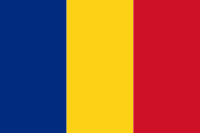
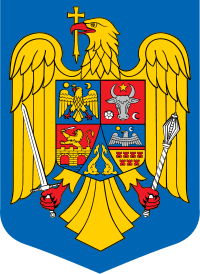
![Location of �Romania��(green)–�on the European continent��(light green &�grey)–�in the European Union��(light green)� —� [Legend]](/I/250px-EU-Romania.svg.png)
